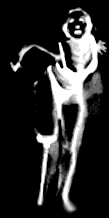« August 2004 | Main | October 2004 »
September 30, 2004
1 year performance video (aka samHsiehUpdate)
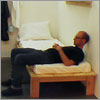
Mimicking Endurance: Who, Me?
"We shall seal images of ourselves in images of our studio, seemingly in solitary confinement inside seemingly identical images of cell-like rooms measuring 10ft x 10ft x 10ft. We seemingly shall not converse, listen to the radio or watch television, until--after you have viewed them for one year--we unseal our images...
"1 year performance video", commissioned by Turbulence, continues MTAA's series of Updates which resound seminal performance art from the 60s and 70s in part by replacing human processes with computer processes. For example, is there meaning in replacing On Kawara's zen-like devotion to his date paintings with an automated script which functions in a similar way?
1 year performance video takes Sam Hsieh's One Year Performance 1978-1979 (aka Cage Piece) and updates it in a number of ways.
First, we've taken the act of living in a cell and transformed it into images of ourselves living in a cell. These video clips are edited dynamically at runtime so that every viewer sees a slightly different cut. The clips are organized according to the clock: if you access the piece in the morning, you see us doing morning things; if you access late at night, you see us sleeping.
Second, we've transferred the onus of a 1 year commitment to the work from the artist to the viewer. The piece will be realized fully only when a viewer runs it for one year. As M.River put it:
"In the work, we mimic endurance without doing the labor. We also know the audience can just close the browser and walk away. No one needs to suffer on this one. The failure is built-in at the front end."
Will a viewer ever complete the work? It's doubtful.
Though the work stands fully on its own, another dimension is added when it's viewed in dialogue with the work that inspired it. The choices made in updating the work we believe speaks to how our society, culture, and the creative process has changed since the original was created.
1 year performance video (aka samHsiehUpdate) by MTAA. A 2004 commission of New Radio and Performing Arts, Inc., (aka Ether-Ore) for its Turbulence web site. It was made possible with funding from the Jerome Foundation.
BIOGRAPHY
MTAA (M.River & T.Whid Art Associates) is a Brooklyn, New York-based conceptual and net art collaboration founded in 1996. Their studies of networked & digital culture & materials; the institutions of art; and the pursuit of the absurd take the form of web sites, videos, installations, sculptures, and photographic prints. Their work has been commissioned by The Alternative Museum, Creative Time, New Radio and Performing Arts, Inc., and The Whitney Museum of American Art and has been exhibited by PS1 Art Center (New York, 2000), The Walker Art Center (Minneapolis, 2000), Eyebeam Atelier (New York, 2002) and Postmasters gallery (New York, 2004).
Posted by jo at 11:35 AM | Comments (1)
Teletravel
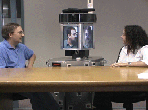
BiReality: Mutually Immersive Mobile Telepresence
BiReality uses a teleoperated robotic surrogate to visit remote locations as a substitute for physical travel. The goal is to create, both for the user and the people at the remote location, the sensory experience relevant for face-to-face interactions. The second-generation system provides a 360-degree surround immersive audio and visual experience for both the user and remote participants, and streams eight high-quality video streams totaling almost 20Mb/s over wireless networking. The system preserves gaze and eye contact, presents local and remote participants to each other at life size, and preserves the head height of the user at the remote location.
Posted by jo at 09:31 AM | Comments (0)
Interactive Cinema

A Real-time Editing Engine for an Algorithmic Sitcom
Office Voodoo is an interactive film installation for two people. It tells the story of Frank and Nancy, two bored Irish officemates, condemned to spend their lives in an office. This infinite film is an algorithmic sitcom inspired from Sartre's play "Huis clos", crossbred with an office life simulator. Two physical voodoo dolls, that represent the protagonists, can be manipulated in order to change the emotions of the characters in the film. It is a social laboratory where the viewers can experiment on the influence of emotions as initial conditions in any social interaction. As viewers get skilled manipulating the dolls, they can control the emotions of Frank and Nancy, and see what happens when : Frank is cranky and Nancy is hyperactive ? Frank is horny and Nancy is depressed ?
The interactive film is made exclusively of real lens-based footage shot with real actors, but it runs on a real-time editing engine that fluidly assembles the film shot by shot as one watches it, while respecting the conventions of continuity editing. The installation is built as a little immersive wooden house for two people - a cross between a confessional, an arcade game booth and a kinetoscope parlour. Download PDF.
Posted by jo at 09:24 AM | Comments (0)
September 29, 2004
Global Interface

Interface at Critical
Mark Marino (of the Barthian and bachelor bots) sends word of Global Interface, a yearlong, interdisciplinary workshop on cyberculture that is just starting up with a talk from Kate Hayles on Monday, Oct 4. Meatspace meetings will happen monthly at UC Riverside, as is explained in the proposal. The diverse set of participants includes faculty from music, dance, and computer science. “The interface serves as the nexus between artist, viewer, programmer, technology, and industry,” the blog for the workshop declares. Mark and the other organizers hope that this blog will foster intersections and conversation online, too, and there’s a plan to post extensive notes on all the talks.
posted by nick on grand text auto, 09.29.04
Posted by jo at 05:16 PM | Comments (0)
Following The Man of the Crowd
![]()
By the Fine Thread of Text Messages
Following The Man of the Crowd is a co-located, 24-hour following piece conducted by Glowlab's Christina Ray and Lee Walton in conjunction with Spectropolis: Mobile Media, Art and the City. It's a 24-hour walk in which two participants, linked by text messaging, drift separately through the city in an alternating pattern according to the movements of strangers. Based loosely on Edgar Allen Poe's short story "The Man of the Crowd" and inspired by Vito Acconci's 1967 "Following Piece," Ray and Walton have developed a collaborative performance that involves following strangers over a 24-hour period. Working as a team connected only through text messaging, the two will alternate turns following selected strangers through New York City.
Date: October 2 - 3, 2004; Time: 10am - 10am; Location: starting at Doma Café, 17 Perry Street at 7th Avenue; end location unknown. Participate! Sign up at Dodgeball.
Posted by jo at 04:52 PM | Comments (0)
People v. technology
Gathering of the Tribes - Sousveillance
Gathering of the Tribes' call for submissions:
"We seek creative works exploring how individuals and cultures artistically respond to and represent our world under surveillance. New media performance emphasizing the importance of public reflection on ubiquitous surveillance and sousveillence is encouraged, as well as essays, short stories, poetry and visual works that assist in defining the ideals of human centeredness in a mechanical and monitored world."
Hmm. perhaps I will submit my percolating critique of sousveillance...
anne galloway's post at purse lips square jaw, 09.29.04
Posted by jo at 04:39 PM | Comments (0)
AVATARA
![]()
Troubling Utopia
From Edward Picot's review of AVATARA's DVD\"Machinima Documentary" by Donato Mancini, Jeremy Turner and Flick Harrison (536 Productions).
Avatara, from a Canadian team called 536, is a documentary about an online community - "a global subculture who spend their lives immersed in an online 3-D voice-chat program", as the blurb explains. What makes this particular documentary special is that "every second... was recorded in-world (ie. online, within the virtual environment), so we don't meet the people directly. Instead, their voices speak to us through the puppet-like 'avatars': rabbits, pharaos, seahorses, giraffes, the grim reaper, flowers, guitars, trolls (etc) which they've chosen to represent themselves in cyberspace." Because of this immersive approach the documentary is more than just a factual report about these people and their private activities: it gives us a sense of what their world feels like from the inside.
Posted by jo at 04:20 PM | Comments (1)
The Invisible Train
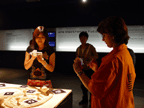
The Invisible Train is a mobile, collaborative multi-user Augmented Reality (AR) game, in which players control virtual trains on a real wooden miniature railroad track. These virtual trains are only visible to players through their PDA's video see-through display as they don't exist in the physical world. This type of user interface is commonly called the "magic lens metaphor".
Players can interact with the game environment by operating track switches and adjusting the speed of their virtual trains. The current state of the game is synchronized between all participants via wireless networking. The common goal of the game is to prevent the virtual trains from colliding. Watch the Quicktime video. Invisible Train will be demonstrated at the International Symposium on Mixed and Augmented Reality (ISMAR 2004) in Arlington, VA.
Originally from waxy. Reblogged by tripp USC Interactive Media Division blog, and by emily on near near future.
Posted by jo at 12:59 PM | Comments (0)
September 28, 2004
more on radio's history, #1
We are learning to launch our winged words. (New York Times, November 5, 1897)
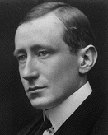
When Gugliamo Marconi, traveled from England to the U.S. in 1898 to demonstrate that Morse Code signals could be sent through the air without wires, he was officiating at the beginning of what we now take for granted: wireless communication.
The fantastic nature of his invention gripped the journalistic imagination of the time and its beneficial use was forecast in elegant prose not unlike that used to usher in the Internet and wireless in our time.
Families and friend now separated would be bound together…A distant friend could call to a distant friend in an electromagnetic voice: “where are you? He would say...[and] A small reply would come “I am at the bottom of a coal mine, or crossing the Andes. Or in the middle of the Atlantic” … Think of what this would mean, of the calling which goes on every day from room to room in a house, and then think of that calling extending from pole to pole, not a noisy babble, but a call audible to him who wants to hear, and absolutely silent to all others. It would be almost like dreamland and ghostland, not the ghostland cultivated by a heated imagination, but a real communication from distance based on true physical laws.” (P.T. McGrath in Century Magazine, March 1902. Quoted in Susan J. Douglas, Inventing American Broadcasting, 1899-1922 , John Hopkins University Press, 1987 – another great book!)
or:
Telegraphy without wires – how attractive it sounds. No more unsightly pole lines disfiguring the streets and highways, ornamented with the dangling skeletons of bu-gone kites. No more perpetual excavation of the streets, to find room beneath their surfaces for additional circuits that cannot possibly be crowded on to the staggering lines that darken the sky with their sooty cobwebs. A little instrument that one can almost carry in the pocket…and if your correspondent be likewise equipped, you may arrest his attention and talk to him almost any time or place, with no intervening medium but the …ether… Possible? Certainly. But will it pay? (Electrical World, June 10, 1899. Also quoted in Douglas, Inventing American Broadcasting)
Marconi's interests were a good deal more practical than the rhetoric used to describe them. He wanted to compete with the cable companies. He wanted to prove that information could be moved faster and more effectively without underwater pipes and he wanted to exploit his invention for commercial purposes. He was a business man.
But the way was not without difficulty. In 1901 he erected an enormous circular aerial in Cornwall, England , "a ring of twenty wooden masts, each about 200 feet high, arranged in a semi-circle 200 feet in diameter", made up of 400 wires and covering an acre of land.
Think of that when you dial that small and infinitely more sophisticated instrument you carry with you today!
On September 17, 1901, one month after Marconi’s elaborate structure was erected, a severe coastal storm blew it down. A few weeks later, its sister antenna on Cape Cod was also blown down.
Marconi began again. He changed his location from Cape Cod to Newfoundland -- opted for one way transmission and a less elaborate system: in Newfoundland he attached his receiving aerial to a kite. And on December 12, 1901, having instructed his assistants in Cornwall to send the code that represents the letter S for three hours each day, he heard the three dots. From Cornwall to Newfoundland -- a distance of 2000 miles.
On December 21, 1902, slightly more than a year after he received the letter S, Marconi succeeded in transmitting a full message from the Governor General of Canada to King Edward VII: “ The New World Sends Greetings to the Old”. In January 1903 he successfully established an American link and sent “most cordial greetings” from President Roosevelt to Great Britain’s King.
And Ray Stannard Baker wrote:
Think for a moment of sitting here on the edge of North America,” , “and listening to communications sent through space, across nearly 2000 miles of ocean from the edge of Europe! A cable, marvelous as it is, maintains a tangible and material connection between speaker and hearer; one can grasp its meaning. But here is nothing but space, a pole with a pendant wire on one side of a broad, curving ocean, an uncertain kite struggling in the air on the other -- and thought passing between." ( "Marconi's Achievement",McClure's Magazine18 (Feb.1902).
Now there's a beautiful idea -- thought passing between!
Posted by newradio at 05:59 PM
oh that ether!

More on Sky Ear
Rereading David Pescovitz’s article State of the Artists, where he discusses Sky Ear–a “surreal electric ‘cloud’ of mobile phones and helium balloons that connect participants with the electromagnetic ether…," I am reminded of early radio.
It was Guglielmo Marconi who first exploited Heinrich Herz’s discovery of electromagnetic radiation and demonstrated that radio waves could be used to transmit morse code over hundreds and then thousands of miles. When he first introduced wireless to America, during the popular America Cup races in 1899, the press hailed him as a hero and a wizard. Wireless itself evoked “psychic metaphors” (see Susan Douglas’ great book, Listening In). It was magic; Popular Science Monthly wrote that it was as if “the nerves of the whole world (were)…being bound together.” And the reputable scientist, Sir Oliver Lodge, one of the leaders of the British Association for the Advancement of Science, suddenly began praising mediums, insisting the dead don’t die and describing contact with the spiritual world. The connection between radio, the ether and spirituality ran strong.
Sky Ear, which is designed to acquaint you with these same "hidden mysteries of the wireless spectrum” by triggering high-intensity colored LEDs within the cloud, seems to be falling on a different sensitivity in 2004, with one correspondent remarking that “putting mobile phones into the clouds just to blink colors is ridiculous.”
Sky Ear had its last public launch in England on September 15, and according to its web site, there are no confirmed "flights" planned for the future, although talks go on. For more on Sky Ear and other works by Usman Haque. For more on radio: Susan J. Douglas, Listening In: Radio and the American Imagination, Times Books, 1999.
Posted by newradio at 04:19 PM | Comments (0)
DENSITY Bus Tour

Sound in Motion
DENCITY is a live performance of electro-acoustic music on a nightly bus tour through New York's hidden landscapes. It is the contemporary urban equivalent of an explorer's notebook- a kind of Huck Finn on land. The producers of the DENCITY project are interested in exploring the relations between our point of departure, Williamsburg and some of the surrounding neighborhoods that have remained on the periphery of most experiences of NYC.
Rather than guide you through these spaces as a standard tour would, your "tour guides" will navigate you through these spaces with sound that is generated on the bus and sounds that have been collected "on site". Your audio "tour guides" will be Heimo Lattner and Erin McGonigle. Two artists who have significant experience performing in a variety of contexts/spaces. They, along with Rene Gabri, have also composed s route that they hope will stimulate new or interesting questions about these peripheral spaces. Read an interview.
DENCITY can be seen as a point of entry into these spaces. The artists involved create a "public" project and a "social" space that provokes the "tourist" or traveler to ask questions about the significance, history, and relationship of these spaces to the spaces they/we normally occupy and navigate through in the City. They also create a context in which the very act of "touring" is both an answer and a question. Sound, architecture, landscape and this tour bus are the forms that will open up these lanes of exploration.
Posted by jo at 03:06 AM | Comments (1)
September 27, 2004
Closed Circuit Videoinstallationen
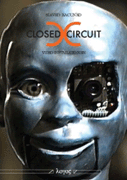
space and time in a global context
After extensive research Slavko Kacunko has published Closed Circuit Videoinstallationen in German. The 1,200 paged book is accompanied by a DVD. It focuses on "the important aspects of the history of media art-"live" video installations. Unlike the few attempts to date to present a survey of the diversity and notably the quantity of international media art, the book is the first to consider the global context in which the sphere of (interactive) media art is developing.
From the historical perspective, links between Europe and the USA, Australia and Asia, Eastern Europe, and South America are highlighted, with focus on regional, national and individual achievements. The book looks in detail at the individual artistic approaches in the context of space and time, and it includes a description and record of 1100 works and 650 artists. This and the notes on further reading and viewing will enable deeper explorations of the material. In recent years, theoretical debate has diagnosed with some precision where the electronic video image stands between analogue and digital codes, or again, between media "representation" and "presentation". This position is subjected to examination against the pertinent examples.
Video technique makes it possible to simultaneously record and reproduce images, sound and sequences of motion; that potential can be seen as a specific characteristic of the medium. The closed-circuit video installations based on it represent the attest field of experiment for the assumptions on art and the theory and history of the medium that it might lead one make."
Table of contents:
Introduction
1. The history of media art: state and competence of research
2. Positioning of current project: visual criticism and cultural criticism
3. Structure and contents
I. Media Art: Category Definitions:
1. "Installation"
2. "Performance"
3. "Input"/"Output"
4. "Feedback"
5. "Immediacy"
6. "Interface"
7. "Interaction"
8. General terminological pairings
a) "Art" and "Medium"
Excursus: "Simulation" and "Metaphor"
b) "Representation" and "Presentation"
c) "Analogue" and "Digital"
II. Closed Circuit Video Installation: A Theoretical Review Prologue: on research specialisms in art and media theory
1. "Subject" - "Object" relationship
2. Constructions of reality
3. System models and behavioural blueprints
4. Game concepts and learning processes
5. Data collation and checking
6. Telecommunication
III. Closed Circuit video Installation: A Geo-historical Overview Towards a Definition: an overview
Suggestion for a Definition
On Structure and Groupings
1. The first decade (1966 - 1976)
2. The second decade (1977 - 1989)
3. The third Decade (1990 - 2002)
Each of these periods is "illustrated" with hundreds of examples of artists and their work from many different countries (In 2. The second decade is from
Denmark mentioned "Golden Boys", Carsten Schmidt-Olsen, Torben Soeborg)
Concluding Remarks
1. The "materiality" of media
2. The "immateriality" of art: the "performative"
3. The "supremacy of appearances": the false mirror
a) "Guardians of the Image"
b) Feedback as pseudo-argument
c) Ecstasy, rationality and reversibility: Apollo and Hermes
d) "Video Spheres" and Irreversibility
4. Closed-circuit as an "open system": target concept - interaction
5. The history of media art: strategies and perspectives
Literature and Correspondence - URLs - Index
The book is accompanied by a DVD-ROM with a catalogue with artists and their works (images, descriptions & URLs).
Posted by jo at 05:38 PM | Comments (1)
swimming together

tunA
tunA is a handheld ad-hoc radio device for local music sharing created by Arianna Bassoli, Julian Moore, Stefan Agamanolis at the Media Lab Europe.
tunA is a mobile wireless application that allows users to share their music locally through handheld devices. Users can "tune in" to other nearby tunA music players and listen to what someone else is listening to. Developed on iPaqs and connected via 802.11b in ad-hoc mode, the application displays a list of people using tunA that are in range, gives access to their profile and playlist information, and enables synchronized peer-to-peer audio streaming. (from the website)
The idea is to use music to connect people at a local level and engender the sense of a shared experience.
Posted by newradio at 01:00 PM
PsyGeoProvflux
![]()
Investigating Public Space
The PsyGeoProvflux was a two day event investigating how the urban landscape of Providence affects its social and artistic community. Sponsored by PIPS, the Provflux was dedicated to further investigations of contemporary psychogeography and experimental forms of public art. We hoped to create new collaboration between groups and individuals working with and interpreting the urban fabric of Providence. One part conference, and two part experimentation, the Provflux included public space reclamations, maps, 24 hour workshops, and lectures in an effort to discover the unseen in the Renaissance city.
Growing from the efforts of Glowlab in NYC and a larger network of psychogeographers worldwide, the Provflux was initiated after PIPS's participation in the first Conflux in NYC. This year the event has grown, including many more artists and projects deciphering the city in a four day event being held at the same time as the Provflux. We hope the energy generated from both shows can lead to further collaboration between artists and thinkers studying the city.
Posted by jo at 12:55 PM | Comments (1)
Urballoon
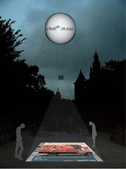
An Urban Media Space
Urballoon is an urban media space: a balloon equipped with a projector and wireless connection to the web that enables people to submit content online and broadcast it in public spaces. The balloon is located in open urban spaces frequented by pedestrians at sunset and night (e.g. plazas, parks). The ball is tethered and floats at a height of approximately 3 stories. The images and text submitted via the site are projected directly below it. By accessing Urballoon people can send text or images which will be queued and shown by the balloon in the order received onto the street. An archive of all submissions can also be browsed.
The balloon is located in the entrance of City Hall Park in New York as part of the Spectropolis event (October 1- 3, 2004). Share with people on the streets by submitting materials to the queue now. Submissions will be projected at sunset. Post an image or text.
Via Mia at popgadget.
Posted by jo at 11:02 AM | Comments (0)
September 26, 2004
QUIXOTE

A Moblog Performance in Turin
During the week of September 23, 2004 Quixote, a puppet, will explore Turin travelling within a network of writers, undefined at the beginning and growing day by day. Their task will be to accompany him around sharing his story with us, chronicling his journey through the city.
Quixote's journey is tracked via a GPS/GSM system in order to show on the website the exact geo-location of each moblog post and to define the topology of the network arisen during the performance. The project is an ongoing investigation around digital mobility and social networks in relation to new forms of mobile expression and interaction.
As of March 2005, Quixote has a new moblog.
Posted by jo at 03:45 PM | Comments (0)
(T)ERROR
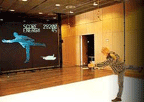
Full Body Engagement
Whom would you like to play to get the world back into right shape? George W. Bush, Osama Bin Laden, or rather Tony Blair? Starting the computer game (T)ERROR, the player is spoilt for choice. A camera tracks the player’s movements and a projector throws the players outlines in original size on a white wall in front of him, all in realtime. When the player kicks, his shadow will kick. When the player ducks or jumps to avoid bumping into an enemy jet, his shadowy avatar will do exactly the same in real time. Watch videos.
Posted by jo at 03:20 PM | Comments (0)
wireless networks
Without the Net
Douglas Rushkoff's Networks Without the Net initiates an exploration of what a wireless network really is. Referencing the work of Julian Bleecker (WiFi Bedouin), MediaLab Europe (tUNA), and Jonah Brucker-Cohen and Katherine Moriwaki (umbrella.net), he suggests that "Just as the Internet fostered a global connectivity for users pinned to their desktops, the wireless network--by going along in one's pocket--... enhance[s] users' connections to their immediate environments and temporary communities."
Rushkoff's concern is that software developers begin to think of wireless devices as "quite capable of constituting new networks, all by themselves," networks that are Internet-independent and focus us on our local environments.
You might want to check the "locative media" on this blog and articles like Kate Armstrong's on location aware fiction. They add strength to Rushkoff's insights and argument.
Posted by newradio at 03:00 PM | Comments (0)
physical proximity
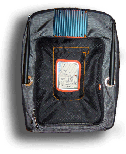
WiFi.Bedouin
Conceived and developed by Julian Bleecker, WiFi.Bedouin is a wearable, mobile 802.11b node disconnected from the global Internet. It forms a WiFi "island Internet" challenging conventional assumptions about WiFi and suggesting new architectures for digital networks that are based on physical proximity rather than solely connectivity. Most significantly, WiFi.Bedouin facilitates the creation of a truly mobile web community.
WiFi.Bedouin is designed to be functional as well as provocative, expanding the possible meaning and metaphors about access, proximity, wireless and WiFi. This access point is not the web without wires. Instead, it is its own web, an apparatus that forces one to reconsider and question notions of virtuality, materiality, displacement, proximity and community. WiFi.Bedouin is meant to suggest that what are often considered two entirely separate realms - virtual and physical worlds - are actually a much more entangled hybrid space. (from the web site)
Posted by newradio at 02:06 PM | Comments (0)
September 25, 2004
street stories

[murmur]
[murmur] is an archival audio project that collects and curates stories set in specific Toronto locations. At each of these locations, a [murmur] sign marks the availability of a story with a telephone number and location code. By using a mobile phone, users are able to listen to the story of that place while engaging in the experience of being there.
Toronto is a city of stories. But the rapid progress and growth that replaces its structures erases its stories as well. [murmur], conceived by Shawn Micallef, James Roussel and Gabe Sawhney, aims to keep these stories alive and on the streets. Their plan is to expand throughout Toronto, step by step, until a [murmur] sign is located everywhere a story the rest of us should hear exists.
For more, read the 8/19/04 Eye article Flaneur by Phone
Posted by newradio at 05:58 PM | Comments (0)
location aware fiction

Hypertext's limit exceeded
The emergence of location aware or physically located narrative works is the subject of Data and Narrative: Location Aware Fiction, a Trace article by Canadian writer and new media artist Kate Armstrong.
Earlier Turbulence blogs have described one of the works Armstrong addresses, 34 North 118 West by Los Angeles artists Naomi Spellman, Jeremy Hight and Jeff Knowlton. Its focus is on "narrative archaeology" and "the investigation of liminal city areas such as abandoned industrial zones, in which layers of time and story are unveiled to the wandering reader/user. As they move through the area, a GPS reading triggers audio fragments in the headphones, resulting in a dynamic fictional experience that follows the user's unique path." (Armstrong)
Armstrong references a second work as well--[Murmur]--by the Toronto-based collective of the same name. [Murmur], she writes, is an "archival audio project"; it "establishes links between narrative fragments and specific points in city neighbourhoods...When a user calls in using a cellular telephone, points in the city scape marked by encoded street signs trigger stories collected from other users and residents."
What intrests Armstrong is how these works push the limits of hypertext by pulling the reader away from the screen and back into physical space. As she says, they "take spatial and navigational relationships outside the almost purely mental space of the computer and posit them in the living city...It is hypertext but without the links between nodes: nodes in physically located narrative works are imbued with content and then left where they can be encountered by the reader/user/walker - in any order, in no order, in an order determined by the movement of the user. The last mechanical determination of the author is erased: the reader has total agency in an uncontrollable, unpredictable, living city. It makes hypertext seem microcosmic, almost sterile - at least more sterile than the world."
Kate Armstrong is a new media artist and writer. Her physically located narrative project PING is on exhibit at the Contemporary Art Centre in Vilnius, Lithuania.
Posted by newradio at 04:49 PM | Comments (0)
Leaders or Followers?
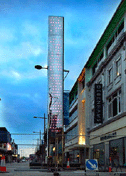
State of the Artists
"Do we drive technology or have we become just passengers? How do we navigate a reality where the lines between the virtual and real are blurred? What is our relationship to our environments, and each other, in an increasingly mediated world?
These questions have been at the heart of electronic art since its birth in the 1960s. It was then that Bell Laboratories Telephone engineer Billy Kluver collaborated with future-minded artists like John Cage and Jean Tinguely on groundbreaking works incorporating, and often critiquing, technology's state-of-the-art. Of course, that tradition continued through the dawn of the digital age and the emergence of the Web. And now it's rising in the vast spectrum of wireless telecommunications." Continue reading David Pescovitz's article at TheFeature.
Posted by jo at 12:06 PM | Comments (0)
New Venue for New Art

This Old House
In the tradition of massive industrial spaces transforming into powerhouse exhibition venues for contemporary art, Ayers Island in Orono, Maine has taken a couple cues. However, so far, said transformation has skipped much of the white-boxing and preserved the majority of the 360,000 square foot former textile factory in all its dilapidated glory. These halls have been reanimated by the first annual Ayers Island Contemporary Arts Festival: 'No Borders', curated by the University of Maine's Owen Smith. Antithetically, the location and history of Franco-Yankee Orono is situated relatively close to the Canadian border, perhaps encouraging the participation of new media students from Montreal, as well as London and Paris. Haunting installations like The Richards' 'Almost', a Xmas-light reindeer nodding from some hundred feet into the creaky depths of the factory, prime the space for the eerie transmissions of more technologically driven projects, like Margaretha Haughwout's .d.a.t.a.l.o.v.e.r., a beautiful game that mediates the playacted interactions of two entered 'lovers' who receive fictional identities from the computer, to reconcile face to face. The festival's closing festivities are Saturday, September 25th from 12 noon to 6 PM. Afterwards, we'll wait for next year, which will surely aid in confirming Orono as a much needed, spacious offline hub for new media bordered within the ever resource-friendly United States. - Kevin McGarry, Rhizome, Net Art News, September 24, 2004.
Posted by jo at 12:05 PM | Comments (0)
September 24, 2004
Tripartite Interaction

Understanding Interaction in Ubiquitous Guerrilla Performances in Playful Arenas
"The inherent freedom of playful arenas with intimate ubiquitous technologies has led to a new breed of guerrilla performance. We draw on theory from computing, performance and club culture to illustrate the Performance Triad model, a method for the analysis, deconstruction and understanding of tripartite interaction in playful arenas. We then apply the Performance Triad to Schizophrenic Cyborg a part reversal of wearable computing technology where the user is outfitted with an electronic communication display and yet this display is visible to others not the cyborgs themselves. This ubiquitous performance investigates the shifting boundaries between performer, participant and observer and of technology-enhanced guerrilla performance." Read the paper by Jennifer G. Sheridan, Alan Dix, Simon Lock & Alice Bayliss.
Posted by jo at 06:15 PM | Comments (0)
Julia Scher

danger dirty data
On Tuesday night we went to Rhode Island School of Art and Design (RISD) to listen to a lecture by Julia Scher. The lecture was the first in a series organized by Bill Seaman, head of the Digital Media MFA Program at RISD.
Scher creates temporary and transitory web/installation/performance works that explore issues of power, control and seduction. She forces her 'actors' and 'audience' to question their roles in regulated space and each to "match the gaze" of the other. She facilitates the 'return' of a person's captured image in the form of a video print, thus bringing into play issues of identity and the internal/external body. Most of the performances Scher discussed involved video cameras and security guards; today, surveillance methods are more sinister--as ACCESS attests--and pervasive than ever: Chicago has 2,000 cameras in place and plans to add an additional 250 in the coming year (see "Chicago Moving to 'Smart' Surveillance Cameras," STEPHEN KINZER, New York Times, September 21, 2004).
Securityland and Wonderland are elaborate online projects Julia Scher created with äda 'web, "launched in 1995 and 1997, respectively; they were preceded by an introductory trailer titled danger dirty data in 1995. Scher offers various areas for user exploration, many of which raise issues of control and personal privacy. All manner of psychologically and physically invasive services and products are seductively pitched at the visitor, promising to alleviate problems caused internally and externally. Loosely based on architectural and clinical models, securityland and wonderland completely destabilize the notion of neutral or straightforward interchange, using inflections that are libidinal, gendered, quasi-institutional and subtly threatening."
Posted by jo at 05:35 PM | Comments (0)
Hot Enough?
Art, Activism and Wireless Technology During the Republican Convention
Monday, September 27, 2004 @ 7:00 p.m. $8
Unexpectedly, the Republican National Convention...provide(d) a common focus and purpose to diverse and divergent initiatives and, in hindsight, enable(d) us to assess their efficiency. Wireless technology is one of the most exciting new developments for political activism. Relatively inexpensive, accessible, and packing tremendous punch with at times just one individual at its origin, it can be used as a tool of protest or opinion-making--the flip side of the near-pervasive electronic surveillance under which we now live.
This panel examines how artists employ wireless technology to reach unprecedented masses, to recast the concept of "collaboration," to redefine and politicize the urban environment, and to achieve unparalleled levels of immediacy. Participants include: Yury Gitman (The Magic Bike ); Natalie Jeremijenko, The Bureau of Inverse Technology, and onetrees.org ( clean air?, antiterror line, sparrow line ); Joshua Kinberg (Bikes Against Bush ); neuroTransmitter and others to be announced. Organized by the Vera List Center for Art and Politics, on occasion of Spectropolis: Mobile Media, Art, and the City, a wireless event organized by NYCwireless, Downtown Alliance, and the Lower Manhattan Cultural Council. Co-sponsored by the Design and Technology Department, Parsons School of Design, and the Department of Communication, The New School.
Posted by jo at 03:49 PM | Comments (0)
unsorted, SonicActsX

Live Cinema
This year Sonic Acts presents a special Live Cinema programme, in association with www.live-cinema.org.
"Live Cinema is a form of performance art in which a human performer manipulates sound and image in synergy through movement, for an audience. In the rapidly advancing field of Live Cinema there are a number of distinct movements, e.g. abstract synthetic cinema, graphic cinema and camera-based cinema. We will present a number of renowned performers from these areas in the small hall in Paradiso in a three-evening packed programme. The performances will be interspersed with interviews with the artists, and with a film and video programme specially compiled for Live Cinema organised in association with Martijn van Boven. A Sonic Acts Live Cinema special will be broadcast on television during VPRO’s Nachtpodium on Wednesday 22 September."
From the introduction to unsorted, SonicActsX: "An important traditional paradigm is the familiar distinction between art disciplines such as visual arts, music, dance, theatre and literature. Usually, the different works of information art are forced to fit within this classical categorisation model. This, however, provides us with a misleading image of the nature of the new arts. For instance, imagine two works of computer art, generated using largely similar algorithms. The first work has an aural output, the second results in visual forms. Then the first one will be labelled as music while the second will be called visual art. This might seem to be an arbitrary problem, but it becomes relevant when we realise that the infrastructures of, in this case, the musical world and the visual arts world operate in rather separated areas (art education, exhibition and performance spaces, criticism and analysis). Many of the interesting issues of (and between) artworks like these are being missed because they are positioned outside the current categorisation models." Read more.
"So what exactly is Live Cinema? Live Cinema springs from new presentation forms, arising as a direct consequence of the advancing digitalisation of visual and sound technologies. The synthesis between sound and image is something a few artists already are putting to practice. While other artists hold ambitions in that direction, a platform/lab gathering know-how and the creative potential digital technologies are inscribed with, is still lacking. The technological backdrop of Live Cinema is one of daily technological innovation in the audio-visual field. The process of digitalisation is most developed in the realm of electronic (pop)culture, where equipment is compact, user-friendly and affordable. All these factors have led to a new artistic practice, where the usage of hardware, such as samplers and computers, have led to new artistic genres and ways to approach art.
It is for these new art forms that I seek fitting formats of presentation, whether theatrical, cinematic, interactive, or on DVD. Live Cinema is all about the "live" event, where artists collaborate and work towards a performance where different artistic disciplines are more than the sum of their parts. Fixed components are music (not soundtrack) and image projection (not traditional film). The eventual result is a unique art experience for the spectator. Each time, just as in theatre or at a concert, it is different." Hans Beekmans
Posted by jo at 03:25 PM | Comments (0)
September 23, 2004
ACCESS
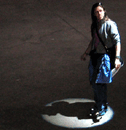
Undesired Spotlight
ACCESS is a public art installation by Marie Sester that applies web, computer, sound and lighting technologies in which web users track individuals in public spaces with a unique robotic spotlight and acoustic beam system. The robotic spotlight automatically follows the tracked individuals while the acoustic beam projects audio that only they can hear. The tracked individuals do not know who is tracking them or why they are being tracked, nor are they aware of being the only persons among the public hearing the sound. The web users do not know that their actions trigger sound towards the target. In effect, both the tracker and the tracked are in a paradoxical communication loop. The ACCESS spotlight system travels from one undisclosed public space to another. The exact location of the public space is revealed only after ACCESS moves to its next location. The ACCESS website, which contains the webcam view and spotlight control, keeps an updated list of the locations visited as well as a video archive. Click here to participate.
Regine blogged this on we make money not art
The content of ACCESS calls for awareness of the implications of surveillance, detection, celebrity, and their impact on society. The structure of ACCESS is intentionally ambiguous, revealing the obsession/fascination for control, visibility, and vigilance: scary or fun. ACCESS was primarily influenced by the beauty of the surveillance representations (x-rayed bodies, luggage or vehicles, 3D laser scans, satellite reconnaissance imagery, etc.), the invisibility of the collected data, and the power generated by means of surveillance practices.
Posted by jo at 07:30 AM | Comments (0)
September 22, 2004
Performing in Space
You can listen to the planet Jupitor and its interaction with its moons; hear radiation from the sun, the sound of activity from far-off pulsars or other astronomical phenomena.
radio astronomy is an art and science project which broadcasts sounds intercepted from space live on the internet and on the airwaves. The project is a collaboration between r a d i o q u a l i a, and radio telescopes located throughout the world. Together they create 'radio astronomy' in the literal sense - a radio station devoted to broadcasting audio from our cosmos.
Radio Astronomy has three parts: - a sound installation - a live on-air radio transmission - a live online radio broadcast - The content of the live transmission depends on the objects being observed at the time by partner telescopes . But whatever they may be, listening in guarantees you'll no longer think of space as silent but rather as a rich acoustic environment prompting comparisons with avant-garde music and electronic sound art.
Posted by newradio at 02:20 PM | Comments (0)
Geo-Cinema

Embedding GPS in Moving Images
"If we can send a picture of a place, why wouldn’t we want someone else to find exactly the same spot? The same angle? The same longitude and latitude? The same Place." Being On Location: The beginnings of a Geo-Cinema & Location-aware video recording. See also: Get Carter 1971 Location List & Days in the Country & Photo recognition software gives location & RAW What happened in that minute before you took a picture? (=place) & this MDVR from March Networks & Data and Narrative: Location Aware Fiction.
originally posted by thomas, 04.11.04 on angermann2.
Posted by jo at 11:21 AM | Comments (0)
BioMapping.net

How Did You Feel?
Bio Mapping is a research project which explores new ways that we as individuals can make use of the information we can gather about our own bodies. Instead of security technologies that are designed to control our behaviour, this project envisages new tools that allow people to selectively share and interpret their own bio data.
The current version of the Bio Mapping system allows people to measure their Galvanic Skin Response (GSR), which is a simple indicator of emotional arousal in conjunction with their geographical location. By sharing this information we can construct maps that visualise where we as a community feel stressed and excited. Will other people’s experiences allow us to engage differently with our environment?
Posted by jo at 10:34 AM | Comments (0)
September 21, 2004
Free phone booth at Burning Man
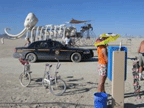
Connected to Nothing and Everyone
Burning Man deliberately takes place in a harsh, remote location. Each year, 30,000+ people gather and build a city of art on the flat playa of the Black Rock Desert in northern Nevada, then dismantle it a week later--to the point that after cleanup, you can't even tell it was there. It's an environment devoted to being appreciated, commerce-free--about art and technology and shared experience.
The Black Rock Desert is where the rocket cars broke the sound barrier. It's a perfectly flat dry lakebed, the location miles from the nearest village of Gerlach, and about 90 miles from Reno, the nearest significant city. In other words, it's about the last place you would expect to find a phone booth, which is why I had to build one. Ideally I wanted a traditional "superman" style booth, and those can be found, but cost a fortune to ship, so we went with a more modern pedestal style phone. The goal was to have the phone just sitting there, mounted on the desert floor, connected to nothing, yet working, just where it shouldn't.
Posted by jo at 02:20 PM | Comments (1)
Villette Numérique

The Specific Nature of Mutant Forms?
The second edition of Villette Numérique brings together actors from international digital culture and invites you, over the course of two weeks, to discover how artists, emerging in ever-greater numbers from different backgrounds, are reshaping contemporary creation. Structured around two exhibitions and numerous events at the crossroads of performance arts, cinema, video-gaming, music and architecture, the festival outlines the specific nature of a mutant and as yet ill-defined emerging art form.
Posted by jo at 02:18 PM | Comments (0)
Instruction works

Tell me what to do
100(11) instruction works is a project for the 7a*11d International Performance Art Festival in Toronto, Canada, from October 20-31, 2004.
For this project, iKatun will accept submissions of instruction works from collaborators in Toronto and around the world via this website. The website will be open for submissions until October 31. During the festival, iKatun will choose one instruction work per day to realize/enact/perform/install. These performance-enactments might take place at the festival or anywhere else in Toronto.
iKatun will perform/enact at least 2 versions of every instruction chosen. We may spend the entire day creating different variations of the same instruction piece to explore the space between script and action, author and performer, festival space and public space. iKatun is also collaborating with InterAccess, an innovative electronic media arts center in Toronto, for the webcasting, streaming video and video documentation of this piece.
Posted by jo at 10:18 AM | Comments (0)
Life: A User's Manual
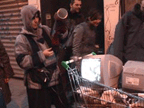
Subverting Surveillance Tactics
Life: A User's Manual is a public performance by media artist Michelle Teran where she dresses up like a bag lady and carries an antenna made out of a soup can while pushing a shopping cart full of televisions along a designated route in Brussels, Belgium. The antenna is connected to a 2.4 GHZ X-10 video scanner which picks up signals from wireless cameras deployed by stores, homes, or police in the buildings and neighborhoods she passes. The found signal is then displayed on the TV in her cart. This type of surveillance is a theme of Teran's work that attempts to make hidden or private CCTV streams into public performance and online mappings. Really interesting take on the act of subverting existing surveillance tactics by displacing the context of the medium.
From her description: “The city is a game board, where every story, every piece stands on its own, but is part of an intricate jigsaw puzzle. Both public physical spaces and private interior spaces contain traces of fragmentary personal [hi]stories tied together by an invisible network of media. How people inhabit the hidden ‘image spaces’, discovered by a wireless surveillance camera scanner, while at the same time inhabiting physical outdoor spaces, is revealed through the practice of walking.” From jonah at coin operated.
Posted by jo at 07:39 AM | Comments (1)
September 20, 2004
Tactical Sound Garden [ TSG ] Toolkit

Shaping Space Through Sound
The TSG Toolkit is an open source platform for cultivating public "sound gardens" within urban environments. The TSG offers the urban dweller a participatory role in shaping the soundscape of contemporary public space: it enables anyone with a WiFi enabled mobile device (handheld, laptop, etc) to "plant" sounds within a networked, 3D audio environment. These "plantings" are mapped onto the coordinates of a physical location, overlaying a collaboratively constructed soundscape onto a specific urban space. Wearing headphones connected to a WiFi enabled device, participants drift though virtual sound gardens planted by others as they move through the city.
Posted by jo at 12:37 PM | Comments (0)
Two Works by Zachary Booth Simpson
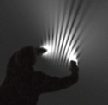
Mine-Control
"(O)ur goal is to use our experience in game development to explore the art of interactivity in contexts other than traditional video games. Our works are both immersive and highly interactive - converting viewers into participants."
Interference: As participants place their hands on the canvas, light emanates in the direction their hand is facing. When a second hand is placed, the light beams interfere with one another creating brilliant and beautiful interference patterns. The simulation is actually an accurate scientific visualization of radio-frequency interferometry, and by the time one has played with it for a few minutes one can't help but intuit the meaning and beauty of Euler's equation even if one has never heard of it! [Download video]
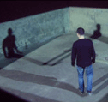 Shadow with Adam Frank, Eyebeam Artists in Residence, New York: A disembodied shadow wanders around alone in a corner. When the participant enters, the figure reacts by running away. Aggressively chasing the figure leads only to his fear and escape. When the participants stay still the figure gains trust and steps closer, finally engaging in an embrace. [Download video]
Shadow with Adam Frank, Eyebeam Artists in Residence, New York: A disembodied shadow wanders around alone in a corner. When the participant enters, the figure reacts by running away. Aggressively chasing the figure leads only to his fear and escape. When the participants stay still the figure gains trust and steps closer, finally engaging in an embrace. [Download video]
Posted by jo at 12:03 PM | Comments (0)
September 19, 2004
connect to art

Nokia's Connect to Art Brings Art to Mobile Phones
Connect to Art is a new dimension of art and Nokia's answer to artists' need to find new, innovative channels for artistic expression and ways to reach new and existing audiences by using new methods.
Connect to Art launches with a mobile exhibition featuring three Finnish artists, Stefan Lindfors, Osmo Rauhala and Kati Aberg. Each artist has created audiovisual works of art that draw on the advantages of new media and mobile phones as an alternative channel for distributing art and as a unique environment for experiencing it.
Nokia's vision is life goes mobile. In the future, people will create, distribute and consume digital information and entertainment almost anytime and anywhere, each according to their needs. Already today, features such as news, music and games can be enjoyed in a mobile environment. It is only natural that art will go mobile, too.
Connect to Art will first be introduced in Finland. Starting with visual artists, the concept will later expand also into music. Connect to Art will later make its debut outside of Finland where artists from other countries will be joining in.
Originally posted by emily at textually.org
Posted by jo at 11:14 AM | Comments (0)
Hubbub
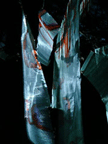
Speech-painting public places
Hubbub is an investigation of how accidental and non-accidental conversations can by catalyzed in urban spaces by means of speech projected onto public surfaces. Hubbub installations may be built into a bench, in a bus stop, a bar, a cafe, a school courtyard, a plaza, a park. As you walk by a Hubbub installation, some of the words you speak will dance in projection across the surfaces according to the energy and prosody of your voice. Read PDF>>
Posted by jo at 07:49 AM | Comments (0)
winding up
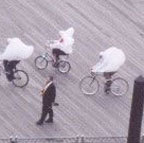
the wind beneath my wheels
The Aeolian Ride, facilitated by Jessica Findley, is a public, open performance in which 50 bicycle riders wear suits that inflate in the wind. She uses email and the internet to get riders, safety guards and documentarians to sign up, and is working towards worldwide exposure. So far, she hit NYC (video and pics on Aeolian Ride site), and is currently looking for volunteers in San Francisco and Cape Town (yay! Art in South Africa!). [Posted by Nathaniel Stern]
Posted by at 02:52 AM | Comments (0)
September 18, 2004
Chased in Brighton and Barcelona
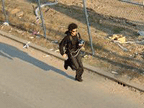
Can You See Me Now?
(from AudioHyperspace of SWR2 RadioART: Hörspiel by Sabine Breitsameter.) Highly recommended: For those who want to experience Blast Theory's live and online game "Can You See Me Now", note the following dates: From 27 September to 1 October 2004, you can take part - corporeal - in Brighton, UK, and from 28 to 31 October 2004, join the game in Barcelona during the "ArtFutura"-festival. Those who cannot make it to these places: It is also fun to join the game online. [more]
Posted by newradio at 10:48 AM | Comments (0)
Automated Prayer Machine

Immersive Radio
The Automated Prayer Machine repositions radio as an antidote to despair. We create an expansive radiophonic sound environment by manipulating signals rebroadcast through a low-watt FM transmitter to multiple receivers in the audience. Digital video projection, live accordion, violin and voice complete the circuit, activating the metaphorical prayer machine.
"Bridging locative media and radio, as well as offering a critical and feminist voice, is the work of Anna Friz...and Annabelle Chvostek...Automated Prayer Machine...seeks to "proactively change the function of radio" by integrating radio speakers into (what was) the audience, thereby "activating acoustic listening space that also has a radio quality... making one aware of being out in the audience, in an immersive radio experience."
Mixing live radio samples, shortwave noise, fundamentalist talk radio, and prayers sent via voicemail and email, Chvostek and Friz are reinserting community voices and empowering wireless practice and discourse by spanning the tradition of radio with an awareness of context and location that addresses the crucial tensions of the wireless arts. For Friz, "radio addresses the same subjects new media tried to address. The hopes are and were the same, the barriers are the same: Who are you when you are in this mediated state? What is it that you want? How profound is this communication, and through the distance and nearness of geography? In new media, the tool still leads the work: beware the tool that leads." From "Sound Tracks and Data Footprints Stalking the footfalls and echoes of the wireless invisible," Tobias C. van Veen, HorizonZero, Issue 15.
Posted by jo at 08:39 AM | Comments (0)
The web is a living organism project
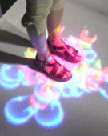
symbiotic relationships
the web is a living organsim project is a net.art installation in both hyper and physical space. It is trying to examine the relationship between internet users, information and the internet itself in the same way we look at the relationship between blood cells, Oxygen and the body itself. By this equation comes a great opportunity of discovering a new model for politics- based on the idea of Symbiotic Relationships. The interactive composition is an examination of microscopic activity inside an internet tissue.
The participants/users are invited to take part in the installation's game system. [1] Each participant/user types in a search string he would like to discuss. [2] When stepping into the interactive stage, he is joined by a microbe. The microbe is a digitally-crafted animated avatar based on the aesthetics of microbiology. Each microbe projects a unique sound and has a unique style of movement. The microbe is powered by a search engine (at this stage we have integrated Google, Altavista and Lycos). [3] In physical space, the interactive stage serves as a screen for a projector that beams from its top. The Microbe is projected upon the user and follows his movements. The search string is projected on the floor right after being submitted. [4] Stepping on text on the floor with the microbe sends the text to the microbe's search engine and returns the title of the first search result. The new text replaces the old ones and become new triggers for a search. The composition creates a conversation between users using search engines combined with a live interactive music score. [5] The work will be available online (controlled by the users mouse&keyboard) constantly like any other net art work but will reach it's full potential in the form of realspace installation that interacts both online users, activating their microbes through the use of the mouse, and physical participants, moving their microbes by the movement of their bodies.
[see online interactive demo for a better grasp of the composition]
The project deals with issues within the discourse of net-ethics, but tries to use the artistic method to create an experience which is theoretically challenging on one hand and pure fun on the other. It is using a physical computed tracking system conjunct with live internet search-engine activity, interactive visuals and sounds and a game system to deliver the concept.
Posted by jo at 08:00 AM
Re:action
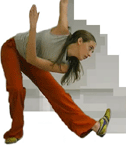
questions of authorship
Re:action is a website and audio visual installation which uses contemporary dance to infuse new media art with the qualities of performance. What first appears to be a dance film in a continuous loop, over time shifts and changes. Unlike a conventional film, the scenes that make up Re:action are not always shown in the same order or from the same viewpoints. Re:action is being re-edited as the viewer watches. However, this re-editing process is controlled not by the artists but by the active participation of the website audience. Simultaneously, the spatial soundscape overlaps in constantly different ways as the viewer moves through the exhibition.
Each journey through the website is recorded and then fed through to the installation, resulting in an outcome which exists only in the moment. The work is constantly remade as each new website user interacts with it in a different way. The control the artists have over the outcome is diminished, emphasising the questions of authorship that arise through collaboration, by extending the collaboration to include the audience.
Re:action is a collaboration between Ed Holroyd, interdisciplinary arts company Eshoda Arts, and filmmakers from Suited and Booted Studios.
Posted by jo at 07:49 AM | Comments (0)
Rafael Lozano-Hemmer

Relational Architecture
FREQUENCY AND VOLUME consists of between 100 and 800 square metres of projected shadows which allow participants to scan the radio spectrum of the city with their bodies. As a shadow appears it tunes any radio frequency between 150kHz to 1.5GHz based on its position monitored by a video tracking system. The size of the shadow controls the volume gain of the specific audio channel. We can have 16 frequencies tuned simultaneously and the resulting sound environment is a composition controlled by people's movements. This piece investigates the contested radio space in the context of the increased surveillance of the body as an antenna. The system tunes all sorts of signals including air traffic control, short wave radio, cell phones, police, taxi dispatch, pagers and more. View Quicktime Movie or look at more projects.
Posted by jo at 07:02 AM | Comments (0)
September 17, 2004
billboard
ABC: Alphabet Billboard Cambridge
Alphabet Billboard Cambridge (ABC) is an interactive portrait of Cambridge and its surroundings, its people and their lives - designed for and displayed at the city's foremost arts space, the Junction. The portrait unfolds in real time over a period of three years on an impressive 7.5-meter electronic billboard running along the southeast side of the Junction, to which participants, residents of the Cambridge area, send images taken with picture-messaging phones provided exclusively for the project.
Each week over a three-year period, one selected person in Cambridge takes part in the ABC project. Each participant is given a phone for the week to use to send pictures as often, or as sporadically as they wish, creating a photo-diary.
Participants take images documenting any aspect of their lives and surroundings - from personal life and people around them to landscapes, favourite places and their jobs - and send them to the billboard, live, in real time. (from the website)
Posted by newradio at 04:50 PM | Comments (0)
Locative Media List
Steve Dietz's Locative Media list
Originally posted by icon from pasta and vinegar, reblogged by Gavin on clippings Sep 17, 2004.
Posted by jo at 01:55 PM | Comments (0)
The Avatar

The Avatar is Legal Voting Age
"I finally got around to scanning my copy of the first print reference for the use of the term Avatar to represent a user's graphical online presence.
Definition Habitat: A make-believe world inhabited by small, colorful creatures, called Avatars. Human beings may visit Habitat and move freely about its regions, interacting at will with with Avatars. Human beings reach Habitat by traveling many miles through tiny telephone lines and entering through a large gateway, called QuantumLink. Once a human being enters Habitat, he or she takes on the visual form of an Avatar, and for all intents and purposes becomes one of these new-world beings. In the world of Habitat, people can play games and go on quests, but mainly they meet other people and have fun. -- Run Magazine, August 1986
The Avatar just turned 18."
Posted by Randy on Habitat Chronicles, September 13, 2004
Posted by jo at 09:53 AM | Comments (0)
Digital Street Game

Physical Battles for Virtual Turf
Digital Street Game is a hybrid game of misadventure set on the streets of New York. It's a battle for turf, a contest of wills in short an excuse to explore the city.
Players compete for turf by performing and documenting stunts on the physical streets of New York in order to claim territory on a virtual map. Stunts are comprised of a random combination of 3 elements: 1) an object commonly found in the city (e.g. bodega) 2) a street game (e.g. stickball) and 3) a wildcard/urban situation (e.g. happy hour). Players interpret these elements as they wish, then stage and photograph their stunt in order to claim a spot on the map. The more stunts players perform the more turf they claim. But of course some players may want to compete for the same territory. In order to hold on to territory, players stunts must score high with the rest of the game community.
Originally posted by Anne Galloway from Purse Lip Square Jaw, ReBlogged by tom at Eyebeam Reblog on Sep 16, 2004 at 11:58 AM
How to play >>
Go to the site and register, select an intersection to claim and get your randomly generated stunt. From there add your own ingredients (friends, mischief, whatever) to pull it off. Photograph your stunt in progress and upload to the site to claim your turf. Repeat as necessary.
When to play >>
The game can be played at any time. There s no official beginning or ending. In other words it's ongoing.
Stunts we love >>
For a quick sampling of stunts, here are some of our favorites.
Posted by jo at 08:32 AM | Comments (0)
Space and performativity
Alan Read's edited volume, Architecturally Speaking: Practices of Art, Architecture and the Everyday. (Feel free to contact Routledge about that path!)
Ewan Forster and Christopher Heighes: innovative and unusual theatre events in and about intriguing and neglected architecture in Britain.
e-state.org.uk - "a site for research into performance, architecture and location. an encounter between performance, urbanism and the everyday."
Archaeology & Performance - "irrevocable acts" of archaeological space and place (and material agency)
Michael Shanks, Towards an archaeology of performance. And Brith Gof - practicing site specific art.
originally from Space and Culture, posted by Anne | January 14, 2004 | 20:43 | permalink
Posted by jo at 07:27 AM | Comments (0)
September 16, 2004
Categorising Multi-Channel Works
"Do categorisations help? After a post by Adam (see 'Another Transmedia Researcher') and my experiences with many 'networked narrative environments' (Andrea Zapp) at BEAP04, I've been thinking more about how and why multi-channel works can and should be categorised. With the great variety of works that have more than one modality (image, sound, text, object...) and works that can be experienced across channels (Internet, Film, Television, Radio, Games...) there is obviously a need to narrow the field of reference. I began by categorising according to whether a work with multiple channels can be experienced in the same space or same arts type or not. Hybrid art, particularly performance pieces with projections, sound, etc. can be viewed by the audience member in their seat. Whereas The Matrix franchise has films, games, comics and so on. These have to be experienced in different spaces, through different mediums. Henry Jenkins calls this type 'transmedia'. But then there is the further difference between works in different mediums that may or may not have a direct part to play in the unfolding plot.
posted by Christy on Cross-Media Storytelling on September 14, 2004 @ 10:49 PM
A website, for instance, may be within the storyworld (like the iRobot website that is actually a site pretending to sell the robots in the film. It does not have any impact on the unfolding plot in the film. It does however play a role in the audiences' experience of the film if visited before. So I then categorised works according to what degree of interaction they have between each other and reference each other. I concluded that we can have multi-channel works that need to be experienced in order to move through or progress the plot (transfiction), works that reference each other and extend the experience of each other but have no direct role to play in the narrative (transmedia), and works that are not necessarily part of the storyworld (a movie website or poster) which are commodities. I'm still not sure about how to term the last category... The works can of course be classified differently if you are observing a semiotic relationship, or even a tangibility continuum. But I was happy with these categories because my aim is to work for a poetics, a creators view of the works. A writer or designer needs to know which works are within the narrative and which are just commodities during the content creation stage.
But then what about forums, fan sites, adaptation comics and so on? These 'unauthored' works do not fit into my content creation approach. Or do they? The text does affect and indeed manipulate the reader in many way. The work can be found in the text and not just the reader or user. I utilise reader response, human-computer interaction, human-agent interaction, human-robot interaction studies in my content creation. The user of a multi-channel work is also affected by reviews, forums, gossip, news and so on. They affect their experience of the work. Where do these community or reader/user/interactor reactions fit into the model then? Well, they do if I view the work as the sum of the original designer, the content, the medium, and the viewer/reader/user/interactor.
So now I see multi-channel works as being categorised by two co-ordinates: narrative relation and stage of creation.
X = transfiction, transmedia, commodity.
Y = pre-publication, initial publication, ongoing publication.
What about a Z? There has to be a Z! Many works and papers presentated at BEAP04 got me thinking about the different types of users/viewers/experiencers/ of a work. In Paul Sermon's At home with Jacques Lacan (2004) [John Curtin Gallery + Central TAFE] the many possible degrees of interaction was evident. The telematic work involves two rooms at different locations. Each is a lounge room with a couch that has a television screen with the image of the couch. When you sit on the couch you can see yourself. When a person at the other location sits on the couch you can see them sitting beside you, and likewise. Together you make up the tv image that is also displayed on another tv for the bystanders to watch as well. Here we have the interactors (the people participating in the scene creation) and the people watching the television image and the interactors, and also people watching via the web. All of these people are experiencing the work, in different ways, and different locations. So here I could categorise them according to proximity to the primary work (the actual loungeroom) -- but there are 2 loungerooms and why are they priviledged over the web experience? So how about role in the creation of the work: a driver and a passenger metaphor perhaps? But there are 3 or 4 groups in this work. According to the medium they experience through could be a system: users (on the web), audience (watching performers and tv), performers/interactors (in the work). A user on a website can actually have an involvement in the creation of the work in other peices so this system doesn't transfer too well. What about the author and the medium then too?
Any suggetions?"
Posted by jo at 07:06 PM | Comments (0)
Extensions Online Journal

for Embodied Technology
The editors of Extensions: The Online Journal for Embodied Technology are pleased to announce the launch of Volume One. Included are six provocative essays by authors concerned with the many new points of contact between our bodies, digital technologies, and aesthetics; and six artworks engaging themes of memory, identity, perception, and performance.
EXTENSIONS is produced by the UCLA Dance and New Media Project. The Project brings together graduate students and faculty from the departments of World Arts and Cultures, Design Media Arts, and Film/TV to explore new intersections between dance and emerging technologies and how virtual space affects our sense of the body, place, culture, and collaboration. Founded in 2002 by Norah Zuniga Shaw, the Dance and New Media Project produces EXTENSIONS and presents annual dance on camera screenings for new work by UCLA students and faculty.
Posted by jo at 09:46 AM | Comments (0)
September 15, 2004
NETROPOLIS

Michael Najjar at BitForms
The work series entitled “netropolis” is an exploration of the way global cities will develop in the future. Of similar magnitude to the impact of the industrial revolution in the late 19th century, it is now computer networks and the information society based on them which are the main vehicles for change, the key elements transforming the face of our urban living spaces.
Three main components characterize this transformation: space becomes the image of space, the city itself becomes a terminal as real space fuses with telematic space. In the telematic society material embodiment is further supplemented and extended by virtual representation: the so-called “tele-polis”. Telematic space endows the urban environment with a new form of structure, intermingling with it and giving birth to a completely unprecedented form of urban space.
OPENING RECEPTION:
Friday, September 17th, 6-8PM
bitforms gallery
529 West 20th Street
2nd Floor
Posted by jo at 09:31 AM | Comments (1)
Elastic Test
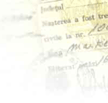
eliminate undesirable foreigners
Immigration authorities around the world need our help!! Use this website to contribute your ideas or proposals for an elastic test that can be devised to eliminate undesirable foreigners.
Immigration Statutes around the world are generally written using vague or abstract notions such as good moral character. It is the messy job of the courts to make such abstractions concrete, to objectively test and measure the moral character of a foreigner, and to eliminate arbitrary or contingent factors from the immigrations process. Join us in doing our part. We will invent, develop and implement numerous elastic tests, which can help the authorities contain and eliminate undesirable foreign bodies. Some of these tests will then be executed on our foreign test subject in a series of live and webcast performances.
Robert Lawrence (UNIMAS, Sarawak, Malaysia and USF, Tampa, Florida) wrote to us about this project on July 22, 2004. He said:
This project from the beginning has had an open door for participation through the web, but currently we are looking for ways to decentralize the project in more significant ways. Some issues related to this on which we are cogitating:
1. Given that our interventions require location-specific collaborations, how can the role of trans-local media, networks or distribution channels be re-imagined?
2. How can the project become less centralized? What are some models of de-centered cooperation we can try to implement – what is the advantage of a distributed network of creators in this case?
3. How might considerations of distribution and re-usability expand the current scope of the work?
4. One of the important aspects of the work is initiating and facilitating new relationships between local communities and structures – is this sustainable?
As we continue to evolve this project and develop ways to ‘turn it loose’ we are very interested in engaging in dialogue, theoretical and practical collaborations, and discovering and developing new models for distance collaboration.
Another of Lawrence's projects Un Message, Evidemment was blogged here.
Lawrence had this to say about it:
"The ‘story’ will be told entirely in the recorded messages that the foreground characters are listening to on their cell phones. These stories will be selected, synthesized and/or adapted from the contributions at this website and other venues. These stories will be gathered in several ways. Whenever the film in progress is shown at festivals, workshops or any other venue people will be asked to contribute storys by phone, sms, email. Participants will be encouraged to engage the performance on any number of levels.
We are also seeking opportunities to workshop the film doing shooting or writing. The “completed” film provides another dimension of the viewer/performer dynamic. At every stage of production, post-production, and presentation the ‘final form’ of the film will be negotiable. It will be shown in a user interactive form on the web, and in ‘concrete,’ though varying, versions in festivals and the usual film art venues – It may not ever appear in the same form twice."
Posted by jo at 08:46 AM | Comments (0)
WACO Reenactment

Audio Warfare
Artist Rod Dickinson will reconstruct the FBI's covert psychological warfare assault on the infamous Branch Davidian religious community in Waco, Texas, at a secret, remote location close to London, on Thursday 16 September.
In 1993, the FBI laid siege to the religious community led by David Koresh for 51 days, intimidating them with a continuous barrage of white noise, rock music and an array of repetitive sounds played at 110 decibels. Using first-hand testimonies from interviews with survivors and academic researchers, Dickinson will recreate some of these original sounds, which included babies crying, circling helicopters, high pitched rabbit screams and dentist drills. The reconstructed audio will be broadcast at 100 decibels at a remote location surrounded by wire fencing and bright floodlights.
The reconstructed audio from the psychological warfare siege will also be streamed over the internet in real time for 24 hours a day for over a month at: www.wacoreenactment.org
For those of you in London:
the ICA Thurs 16 September, Meet in Foyer at 7pm for Coaches
**Please** book in advance!
£8, £7 Concs. £6 ICA Members
ICA, The Mall, London, SW1
Tickets & Information: 020 7930 3647 / www.ica.org.uk
The ICA Thurs 16 September, Meet in Foyer at 7pm for Coaches
**Please** book in advance!
http://www.wacoreenactment.org
Posted by jo at 08:15 AM | Comments (1)
Water Gongs-performance art bot
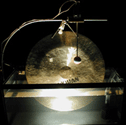
Waterways as Networks
the water gong bot, by David Birchfield is a dynamic, autonomous, robotic installation that is comprised of a network of seven water gongs that resonante at fluctuating pitches as the water levels rise and fall. As the gongs resonante, the surface of the water in the tanks ripple; and as the solenoid actuators alter their pulse rates, and the illuminating lamps dim and rise, the visual ripples and shadows change intensity and character.
The rise and fall of water in each water gong tank references tidal cycles. Water serves as the means of communication between nodes in the network, and this anachronistic method references the use of waterways as the traditional vehicle for communication and transportation. The network of water gongs also share a limited resource of water, and its constantly shifting allocation between the members of the system models the shifts of natural, cultural, and intellectual resources throughout the networks of our local and global communities. The sonic and visual aspects of the piece represent the states and shifts of the network as it passes through moments of stability and instability.
Posted by jo at 08:05 AM | Comments (0)
September 14, 2004
No plant left behind
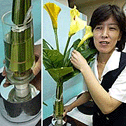
Flower Sound
A Japanese company has developed a way of turning plants into audio speakers, USA Today reports.
"Called Ka-on, which means "flower sound" in Japanese, the machine consists of a donut-shaped magnet and coil at the base of a vase that hooks up to a CD player, stereo or TV. Place the flowers in the vase, turn on Ka-on and the magnet and coil relay the sound vibrations up the stems through the plant's water tubes."
And the plant trembles.
Later on this month (the company says) you'll be able to carry on a telephone conversation with the plant. And soon a wireless connection will be available for piping music to the Ka-on.
This is not nature speaking a computational language and answering questions of fundamental theoretical and experimental interest, as Neil Gershenfeld, director of MIT’s Center for Bits and Atoms, speaks of it. It's us doing what we want with nature yet again. No wonder the poor plant trembles!...
Posted by newradio at 06:21 PM | Comments (0)
UpStage

UpStaging Performance
A new medium for online performance, theatre and storytelling is now in its first release. UpStage is a web-based venue and tool for artists to compile different digital media for textual and audiovisual communication into a live performance, in real time, for online audiences.
The first release of the software was launched on 9 January 2004, and online walk-throughs were held on in February to give people an idea of how UpStage works from the player's perspective. These sessions will be continued on a regular basis, lead by the members of Avatar Body Collision. If you are interested in having a hands-on experience with the software, and participating in live improv sessions, email colliders at upstage.org.nz for further information and to be notified of times. Visit the UpStage foyer, from where you can access a sample stage.
Currently, UpStage is being used for WorldX, a virtual exchange between schools in the UK and New Zealand, and DTN2, the first cyberformance using UpStage, was performed live from the Machinista Festival in Glasgow on Sunday 9 May.
Posted by jo at 06:09 PM | Comments (0)
Report from ISEA 2004

Report from ISEA 2004
by Jonah Brucker-Cohen
ISEA 2004: August 14-22, 2004, Helsinki (Finland), Baltic Cruise, Tallinn (Estonia)
Held over a week and located in Helsinki, Tallinn, and a Baltic Sea-roving cruise liner, ISEA 2004 was a marathon media arts conference like none other. With over 1,500 artists taking part in panels, performances, fashion shows, keynotes, and installations, there was little time for sleep among all of the commuting between venues. The conference's theme examined the crossover between wireless culture, wearable or fashionable technology, and networked experience. ISEA 2004 aimed to explore themes surrounding critical notions of interaction design, open source software culture, and geopolitics of media. This approach attempted to challenge accepted notions of interaction by focusing on possibilities of re-appropriation instead of mere re-evaluation. Although the conference schedule was an often strenuous journey through multiple cities and events, the discussions, interventions, and realizations that manifested contributed to an exhilarating experience.
The festival officially began aboard the "Networked Experience" Baltic sea cruise (I missed the Koneisto sound event the night before in Helsinki), where the focus was on how networked culture iterates human understanding through shared experiences such as email lists, collective performance, interactive narrative, and GPS sound installations. The panel entitled "The List: The mailing list phenomena", began in the Metropolitan ballroom of the ship, with a panel of list-serve moderators such as Melinda Rackham of Empyre, Kathy Rae Huffman of Faces, Axel Bruns of Fibre Culture, and Charlotte Frost who is studying list culture for her Ph.D. thesis. Examining networked culture, the debate centered around the nurturing of lists and what types of communication technologies are appropriate for specific communities. I spoke on the challenges of my BumpList project as an example of an email community that focuses on shifting the structure of a system to change its participants behaviors. Other panels and events focused on community awareness in digital media projects like "E-Tester" and UNESCO meetings with African and Asian award winners and participants.
Arriving bewildered and tired in the city of Tallinn, Estonia, the "Wearable Experience" theme of ISEA began with a keynote from Concordia University's Joanna Berzowska. Her talk was an overview of wearable trends and projects that aimed to challenge traditional notions of strapped-on gadgetry by emphasizing the integration of sensors and displays into clothing. Her own research on "Memory Rich Garments" showed how everyday emotions and intimacy could be projected and enhanced through computationally enhanced clothing that stores non-personal data about people it comes into contact with. ther panels focused on the how technology and fashion can integrate into networks, how clothing can act as a display for portable signage, or how intimacy could be conveyed over distance. This discussion continued to Helsinki's "Wireless Experience" theme, which began as hundreds of ISEA attendees were stuck in passport control after arriving on the SuperSeaCat ferry from Tallinn. Machiko Kusahara of Japan's Waseda University opened the conference with a keynote address on mobile phone culture in Japan. Her focus centered around how "socially acceptable" mobile phone or "ketai" use had become and how advertisements for services emphasized how "left out" of mainstream culture people have become without a phone. Although her talk emphasized the social pressures of technology, it left out dangers of extended mobile phone use or the advent of surveillance culture. These questions were made more evident through the many parallel sessions over the next few days.
The second keynote by the Sarai New Media Initiative's Shuddhabrata Sengupta focused around the conference theme of "Histories of the New" and how reinventing the future is often tied to lessons from the past. His talk "The Remains of Tomorrows Past: Speculations on the Antiquity of New Media Practice in South Asia", presented the history of technical networks from the telegraph to the Internet. His talk referenced Tom Standage's book "The Victorian Internet" to illustrate how these information networks are not new and how they simply provide frameworks for a centralized space that expands global discourse. UCLA's Erkki Huhtamo, followed this talk with his take on the "Archaeology of Mobile Media", or how media does not exist independently from the social framework that envelops them. He showed imagery of the amateur photographer of the early 20th century comparing the public perception of this "nuisance" to the current mobile phone camera phenomenon: both seen as invasions of privacy and unwanted surveillance in the hands of the people.
Following this theme, the GPS art panel, moderated by San Francisco based-artist Marisa Olsen, attempted to ground location-based media projects into a defined genre. The current ghettoization of media art into technology-defined categories like GPS or Wi-Fi tends to counter creativity at its roots. Instead the focus should be on crystallizing an idea so that the technology becomes less awkward and central to the output. Projects discussed included Pall Thayer's "Hlemmur in C" that tracked taxi movements through GPS and composed real-time soundtracks based on their position in the city, Joel Slayton's (of the C5 collective) mapping of altitudes on the Great Wall of China to plot where it could have been built in California, and Teri Rueb's "Trace" which allows people to discover location-based sound clips embedded into positions on a nature trail in Canada. In a sense, most of the work in this area centers on GPS enabling you find or discover things in your environment or enabling people or devices to find you. Little was mentioned about the surveillance aspects of tracking or the social aspects of why this technology is becoming pervasive?
Filling in the hard theory was keynote speaker Wendy Hui Kyong Chun of Brown University who spoke on "Control and Freedom: Interactivity as a Software Effect". Her talk was probably the most seminal moment of the conference as it connected up the central themes. Chun emphasized the role of technology as a contributor to social stigma especially in networked culture and outlined how surveillance is becoming a visual and territorial metaphor for control. Her breakdown of the utopian view that current software assumes that users cannot understand computation showed explicitly how layers of mediation between code and interface are getting thicker. Nina Wakeford of the University of Surrey spoke on "Identity Politics of Mobility and Design Culture", focusing on the importance of local knowledge with examples of projects that emphasized aspects of mobility as a driving force in design.
The exhibitions scattered around Tallinn and Helsinki showcased everything from fashion tech and accessories to social and political projects, to interactive installations and data visualizations. Some impressive projects included Bundith Phunsombatlert's "Path of Illusion", a series of street lamps with rotating LED displays that passerbyers could type into rounded keyboards at the base of the lights. Also meant to display information in public space was Steve Heimbecker's "POD (Wind Array Cascade Machine)" which consisted of sixty four air flow sensors in Montreal that transmitted data to towers of LEDs that resembled a large-scale graphic equalizer. Also interesting was Diego Diaz's "Playground" which turned a kids merry-go-round into a collective joystick to navigate a shared 3D space. I think someone got overexcited and broke the piece midway through. In Tallinn, the wearable showcase features Tina Gonsalves and Tom Donaldson's "Medulla Intimata", video jewelry that changes depending on the emotional state of the wearer and the conversations in which they are engaged. Other projects such as Kelly Dobson's "ScreamBody" which consists of a bag you scream into and release the sound later, Sabrina Raaf's "Saturday" which used gloves with bone transducers to hear sampled CB radio conversations through your cheekbones, and "Seven Mile Boots" by Laura Beloff, Erich Berger and Martin Pichlmair that allows people to traverse chat rooms by walking around a physical space. Overall the projects in the show examined how wearable technology can impact and change our environment, personal experience and social landscape
As ISEA ended, most people were thoroughly exhausted. Although the constant shifting of venues, cities, and themes might have contributed to this, the questions raised by the presentations and exhibitions remained strong throughout the event. Why is interaction engaging? Is there a larger message involved? How do creative systems and practice filter up to decision and policy makers to provoke and result in global action? With diverse speakers such as the Sarai Collective's challenge to the hegemony of the digital art canon and Mark Tribe open-sourcing his presentation online so that people could "remix" it after his talk, the conference presented a wide array of contrasting opinions that attempted to make sense of the current media arts landscape. With so many perspectives, the endpoint seemed scattered but also manageable. The more we question the fundamental reasons why technology is important, the more we discover why we cannot live without it. Only through events like ISEA can we really come to grips with this realization.
Jonah Brucker-Cohen (jonah (at) coin-operated.com)
originally published on coin-operated
Posted by jo at 01:18 PM | Comments (0)
September 13, 2004
Mobile Feelings
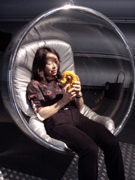
Involuntary Actors
"While mobile phone users are generally glad to embrace the enormous advantages of being reachable any-time and any-where, a reduced sense of privacy combined with the involuntary witnessing of anonymous people's private businesses has created a strange and sometimes awkward form of self-awareness and attention towards others. Mobile phones have transformed ordinary people into actors who narrate their most private details on the theatrical stages of train stations, restaurants, public spaces, streets, meeting areas, and any other social gathering places.
"Mobile Feelings is an artistic project that explores the ambivalence of sharing personal information with an anonymous audience. Instead of communication via voice or images to people we know, Mobile Feelings lets people communicate with strangers through virtual touch and body sensations including smell and sweat using specially designed mobile phones." Read more.
Mobile Feelings, a work by Christa SOMMERER & Laurent MIGNONNEAU, was part of Transmitter, April 21st - May 23rd, 2004; Kunsthalle Dominikanerkirche and around the city of Osnabrück.
Posted by jo at 11:58 AM | Comments (0)
Digital Performance Archive
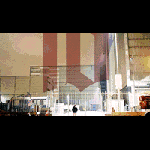
The Digital Performance Archive (DPA) was a major research project documenting developments in the creative use of computer technologies in performance--from live theatre and dance productions that incorporate digital media, to cyberspace interactive dramas and webcasts. DPA also collated examples of the use of computer technologies to document, discuss or analyse performance--from specialist websites and e-zines, to academic CD-ROMS. As a central aim DPA collated an extensive online searchable database of virtual theatre performance and related events 1990-2000, including selected video documentation and statements by creators. You can search by keywords, technologies (drop down menu) and practitioners.
Posted by jo at 09:34 AM | Comments (0)
September 12, 2004
mobile performance group
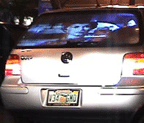
(auto)mobile performances
04.15.04 Downtown Orlando FL: Using the automobile as a mobile performance apparatus MPG presented a live performance which included real-time video and audio processing techniques. This project used two cars, one with audio performers the other with video performers. Using wireless networking and a FM transmitter the two cars where able to keep in sync and perform together as they moved through the city. Performers where Laura Oxendine, Adam Roberts, Martha Garzon, Damion Waters, Bryan O'neal, Ben Hustis, Julius Santiago, James Auten, Chester Udell, Jamie Tauler. Project Leaders where Nathan Wolek, Matt Roberts.
MPG:Mobile Performance Group is a collective of new media artists interested in finding new ways to present art outside of traditional venues. The Group was founded by Matt Roberts and is based in Florida. Using custom video and audio software instruments in real-time, and original video and audio recordings, Roberts and Wolek will present a meditation on the Florida Landscape which will be realized as an improvised new media performance at the New Forms Festival, Vancouver, Canada on October 24, 2004.
Posted by jo at 04:46 PM | Comments (0)
September 10, 2004
Textual @traction

Audience gets the message
In the new movie about text messaging--Textual @traction--audiences "will be able to see the messages exchanged between leading characters-on their own mobiles...The film centres on a young man who finds a lost mobile phone and starts replying to text messages from a mystery stranger...What makes the film unique is that the audience does not actually get to see the messages on screen...Instead, by pre-registering, they receive the texts to their own phones at the same time as the characters on screen." Karen Price, The Western Mail, Sep 9 2004. Textual @traction has been selected to compete for Best Short Film, Best Foreign Film and Best Drama, at this year's Los Angeles International Short Film Festival. Posted by emily 09.09.04 | 05:54 PM on textually.org
Posted by jo at 10:09 AM | Comments (0)
September 09, 2004
tanz performance köln

European Complements
tanz performance köln founded in 1989, develops concepts and realizes dance-related series, festivals and dance film programs, that are representative of new developments in contemporary dance both nationally and internationally including projects with a strong focus on new media technologies. Their projects include DAMPF_lab, an interdisciplinary collaborative project fostering new and distinctive art works of high quality that integrate interactive media technologies with the performing arts while seeking insight into questions such as: how do emerging software practices impact performance; what is the experience of the performer on an interactive stage; how are the relations between maker, performer and audience still shifting; and what are the aesthetic/social consequences?
tanz performance köln partners include:
Animax Multimedia Theater (est. 1999) of the Bonn Development Workshop for Computer Media (est. 1985) focuses on the roduction/presentation of media arts and provides an outstanding operational basis for the exploration of new interactive technologies in the area of performance arts and immersive arts.
Ars Electronica Center/Futurelab offers one of the best-equipped and most efficient research and development workshops for Interactive Spaces, Virtual Environment and Digital Surfaces in the context of Ars Electronica which has been an internationally unique showcase for digital art and media culture and encounters between the arts and sciences since 1979.
V2_Lab is the aRt&D department of V2_, Institute for the Unstable media (est. 1987) that concerns itself with research and development in the field of art and media technology and brings to the project a variety of knowledge/ expertise derived from an interdisciplinary approach to the field of unstable media including specific critical perspectives.
Partners work on the following complementary strands:
research labs aiming to generate shareable outcomes by drawing questions from and in turn supporting the creative work of the co-productions; stimulating other new artistic work; innovating technology solutions together; and devising unique dramaturgical and user testing approaches to the artistic process. In addition, the labs will gather documentation to contribute to theoretical and educational approaches to this area of work.
co-productions aiming to nurture and help realise two specific art works: composer/director Klaus Obermaier working with the Ars Electronica Futurelab to develop interactive media technologies for use in a new performance for the stage; and choreographer Angelika Oei working with the V2_Lab on the creation of a large scale performance/ interactive media installation work.
Associate researchers:
Matt Adams (Brighton/ London)
Daniel Aschwanden (Vienna)
Johannes Birringer (Nottingham)
Carol Brown (London), Nuria Font (Barcelona)
Nik Haffner (Frankfurt/ Barcelona)
Prue Lang (Frankfurt), Cindy Lee (London)
Martin Kusch (Vienna/ Montreal)
Christopher Salter (Berlin)
Stephanie Thiersch (Cologne)
Ariella Vidach (Milan)
Posted by jo at 01:09 PM | Comments (1)
September 08, 2004
Transmute
emotional and spatial residue
 Intimate Transactions: First Proof of Concept by Keith Armstrong + The Transmute Collective (c) 2003: "A performing body carves through the space, energizing & sculpting the environment in which it inhabits. Stillness is very important. The moment before & after a movement is crucial. The emotional & spatial residue left behind from each action is where the drama lies." Lisa O'Neill
Intimate Transactions: First Proof of Concept by Keith Armstrong + The Transmute Collective (c) 2003: "A performing body carves through the space, energizing & sculpting the environment in which it inhabits. Stillness is very important. The moment before & after a movement is crucial. The emotional & spatial residue left behind from each action is where the drama lies." Lisa O'Neill
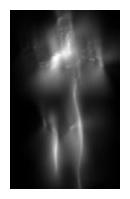 And, from the introductory essay by Linda Carroli (c) 2004: "Presently, in Brisbane, 'mixed reality' works...are emerging as a focus for artistic and creative industries research with several projects currently in development. Transmute's core ideas were presented in an "evolving audio-visual experience driven by a highly tactile interface that requires active physical engagement. Individual participants...navigate by either drifting or traveling actively within a landscape comprised from ghostly bodies, dynamic texts and emergent sound." To be more specific: The work is comprised of several elements including a 'body shelf' designed by Zeljko Markov which is the interface; interactive imagery comprising a text-based non-narrative drawing on the story Smog by Italo Calvino and an interactive imagescape based upon a single, ambiguous body image (pictured left) which dissolves, morphs and transforms between states of sublime calm and pixillated agitation; and a fluid interactive soundscape designed by Guy Webster (and his collaborators Woods and Jenkins). Participants are literally shelved on the body shelf in which a number of sensors are positioned to correspond with their hands, feet and back."
And, from the introductory essay by Linda Carroli (c) 2004: "Presently, in Brisbane, 'mixed reality' works...are emerging as a focus for artistic and creative industries research with several projects currently in development. Transmute's core ideas were presented in an "evolving audio-visual experience driven by a highly tactile interface that requires active physical engagement. Individual participants...navigate by either drifting or traveling actively within a landscape comprised from ghostly bodies, dynamic texts and emergent sound." To be more specific: The work is comprised of several elements including a 'body shelf' designed by Zeljko Markov which is the interface; interactive imagery comprising a text-based non-narrative drawing on the story Smog by Italo Calvino and an interactive imagescape based upon a single, ambiguous body image (pictured left) which dissolves, morphs and transforms between states of sublime calm and pixillated agitation; and a fluid interactive soundscape designed by Guy Webster (and his collaborators Woods and Jenkins). Participants are literally shelved on the body shelf in which a number of sensors are positioned to correspond with their hands, feet and back."
Posted by jo at 11:40 AM | Comments (0)
CitiTag

mediating social experience
CitiTag is a wireless location-based multiplayer game, designed to enhance spontaneous social interaction and novel experiences in city environments by integrating virtual presence with physical. In the first version of CitiTag you roam the city with a GPS- and WiFi-enabled iPaq PocketPC in search for players of the opposite team that you can ‘tag’. You can also get tagged yourself if one of them gets close to you. Then you need to find a friend to free you. Urban space becomes a playground and everyone is a suspect.
Posted by jo at 11:03 AM | Comments (0)
September 07, 2004
Two Textual Instruments

Playing Text
Today, Turbulence launched Two Textual Instruments, Part 1: Regime Change by Noah Wardrip-Fruin, with Brion Moss, David Durand, and Elaine Froehlich. "Textual instruments make text playable in a new way. At first, as one encounters their workings, they are toys for exploring language — more flexible than link-node hypertext, more responsive than batch-mode natural language generators. With growing experience, these instruments can also become tools for textual performance.
The two instruments we are constructing operate using the statistics of n-grams, a technique used for textual games for more than 50 years (the first game appearing in Claude Shannon's 1948 "A Mathematical Theory of Communication"). These n-grams are chains of words, and these instruments use shared chains between documents as "bridges," allowing movement from the text of one document into a body of text created from others (and back). By using this approach to make text playable, by taking the logic of word chains to defamiliarizing and sometimes humorous extremes, Regime Change (and the forthcoming News Reader) provide ways to perform William Burroughs's injunction to "cut word lines" — to break the chains of conceptual association that say this follows from that, regardless of the logic case, but rather because of the constant association of these words in the speech we hear and echo to others on a daily basis."
Posted by jo at 12:37 PM | Comments (1)
Weather Report
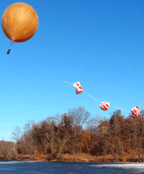
Drifting Voicemail, Found Sounds Stories
"A simple but clever installation in Tallinn, "Weather Report" by Janek Schaeffer, consisted of helium balloons and an MP3 player/cell phone. Recordings gathered by starting a cell phone call and then sending the phone up into the atmosphere attached to a weather balloon while recording the call on voicemail are remixed with other weather noises, to be played back on the cell phone in the installation." from ISEA 2004: Art Report by scott @ 10:10 pm, 09.05.04.
From Schaeffer's web site: "The weather balloons were used in 3 main ways. Firstly one icy winters morning I attached a mobile phone to receive and send low resolution sound, letting it float away from the surface of a frozen lake. Secondly using a digitaldictaphone I made time lapse recordings of the sky by floating it 500ft above my lush metropolitan neighbourhood. Lastly a few all American friends and I set out to shootthe balloon down late one June afternoon leaving the sound to parachute back to earth. I let the recordings speak for themselves, no effects, no eq, just straight cut & splice collage where you can hear the edges of time. Some other sounds collected include: underwater ice skaters; flapping; old meteorological kit; leaf blowers; repairing weather damage; various 60's archive audio; melting ice, ski across snow, Minnesota forecasts on radio, in the car and on TV; Tornado chasing & test equipment; snow flakes landing on mic; squeaky tree; National Weather Service balloon launch; walkie talkie tones from my Science Museum workshop etc. Oh, and all temperatures in Farenheight...
The result is a highly compressed Found Sound story, heard as a drifting voicemail message from the weather balloon. A hybrid documentary collected and edited outdoors, where it is designed to be heard walking with headphones... so.. go find a Walkman!"
Posted by jo at 10:25 AM | Comments (1)
UNSTABLELANDSCAPE

Dance and Mutable Media
"I envision the development of UNSTABLELANSCAPE beyond the local performance and gross movements of the dancers towards the use of autonomous streams of data, subtle measurement of biological functions (breathing, heart beat, earth movement, GP systems and distributed performance using the internet)...I would like to explore the augmentation of the system hybridicity and maximizing its bottom-up architecture with the integration of organic tissue such as neurons and muscle cells to the real time aspect of the video-sound-movement continuum (residency at Simbiotica, Australia). Later, I will expand the performance with this bio-digital generativity and with analog/biologically inspired robots. It is a continuation of the aesthetics of emergence."
marlon barrios solano
Posted by jo at 10:06 AM | Comments (1)
September 05, 2004
Work by Usman Haque
Usman Haque designs interactive architecture systems and researches how people relate to each other and their spaces. "The domain of architecture has been transformed by developments in interaction research, wearable computing, mobile connectivity, people-centered design, contextual awareness, RFID systems and ubiquitous computing. These technologies alter our understanding of space and change the way we relate to each other. We no longer think of architecture as static and immutable; instead we see it as dynamic, responsive and conversant. Our projects explore some of this territory." Performative works include:
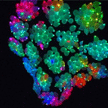 Sky Ear, 2004: This non-rigid "cloud", made up of several hundred glowing helium balloons will be embedded with mobile phones. As visitors to the event call into the cloud to listen to the distant electromagnetic sounds of the sky (including whistlers and spherics), their mobile phone calls will change the local hertzian topography; these disturbances in the electromagnetic fields inside the cloud will alter the glow intensity of that part of the balloon cloud. Quicktime video: 19 MB
Sky Ear, 2004: This non-rigid "cloud", made up of several hundred glowing helium balloons will be embedded with mobile phones. As visitors to the event call into the cloud to listen to the distant electromagnetic sounds of the sky (including whistlers and spherics), their mobile phone calls will change the local hertzian topography; these disturbances in the electromagnetic fields inside the cloud will alter the glow intensity of that part of the balloon cloud. Quicktime video: 19 MB
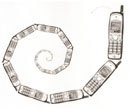 Japanese Whispers, Tokyo (2000): Similar to the children's game known as "Chinese Whispers" or "The Telephone Game," this project looks at how a message is changed by being passed from one mechanism to another--in this case the cellphone.
Japanese Whispers, Tokyo (2000): Similar to the children's game known as "Chinese Whispers" or "The Telephone Game," this project looks at how a message is changed by being passed from one mechanism to another--in this case the cellphone.
Cellphones are laid in a circle and calls are initiated from one phone to another in a variety of patterns with differing results. The sound degrades at each step as it is transformed from analog to digital and back again, emphasising the circular nature of communication. The iterative process of the feedback loop amplifies miscommunications inherent in the transmitting of information. Quicktime video: 9.2 MB
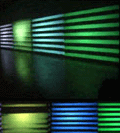 Infinitum Ad Nauseam, Tokyo (2000): The project is a video/audio performance installation which requires the explicit participation of the audience. Essentially, the system uses video and audio feedback to create sounds (from images and movements) and images (from sounds and movements). 4 video cameras, 4 video projectors, 2 video mixers and an audio mixer are used to initiate a massive feedback loop of video-video, video-audio, audio-video and audio to audio. This creates dynamic real-time images and sounds in "conversation" with the visitors or performers. There are no pre-recorded images and no computerised images used in the installation. Videos>>
Infinitum Ad Nauseam, Tokyo (2000): The project is a video/audio performance installation which requires the explicit participation of the audience. Essentially, the system uses video and audio feedback to create sounds (from images and movements) and images (from sounds and movements). 4 video cameras, 4 video projectors, 2 video mixers and an audio mixer are used to initiate a massive feedback loop of video-video, video-audio, audio-video and audio to audio. This creates dynamic real-time images and sounds in "conversation" with the visitors or performers. There are no pre-recorded images and no computerised images used in the installation. Videos>>
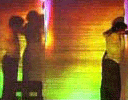 Changing Faces of Gesture, Tokyo (2000) with Charlotte Boye-Christensen (Choreographer/Dancer): The performance consists of one person and 2 to 4 large video projections. Using a simple video feedback system (where a video camera is pointed towards the screen upon which its image is being projected) coupled with an audio feedback system, complex images are created in realtime which are manipulated by the performer's movements. Images created resemble reflections in a puddle; these can be coloured using filters on both the cameras and the video-projectors. Furthermore each projector can be separately controlled to multiply the effects and simulate everything from a solitary dancing figure to a bustling crowd of people. Videos>>
Changing Faces of Gesture, Tokyo (2000) with Charlotte Boye-Christensen (Choreographer/Dancer): The performance consists of one person and 2 to 4 large video projections. Using a simple video feedback system (where a video camera is pointed towards the screen upon which its image is being projected) coupled with an audio feedback system, complex images are created in realtime which are manipulated by the performer's movements. Images created resemble reflections in a puddle; these can be coloured using filters on both the cameras and the video-projectors. Furthermore each projector can be separately controlled to multiply the effects and simulate everything from a solitary dancing figure to a bustling crowd of people. Videos>>
Posted by jo at 11:42 AM | Comments (2)
September 04, 2004
Work by Don Ritter
Physical Aesthetics
"Unlike art from previous times, interactive art considers the viewer’s body as an integral component of the experience; the quality of this experience is measured by the term physical aesthetics, being the pleasantness or unpleasantness of the physical experience involved with the control of an interactive experience. The involvement of a viewer in an artwork could be viewed as being more democratic than the autocratic experiences presented by older art forms." Read the full interview.
![]()
Vox Populi endows anyone with leadership, regardless of their personal wealth, family origins, or political connections. A video projected crowd chants "speech, speech" and encourages visitors to speak from a lectern. When a visitor speaks through the microphone, the voice is amplified and political speeches begin scrolling on a teleprompter located within the lectern. In response to a speaker’s voice, the crowd reacts with varying degrees of support and repulsion.
Other works by Don Ritter (Real movies available on site):
The Technophobe and the Madman: Internet-2 distributed musical
telecommunications video-music performance, 2001; 12 channels audio and 6 channels full screen video connection between Frederick Loewe Theatre, New York City and iEAR Studio, Troy, New York; collaborative performance: performers share audio and video between 2 cities.
Performance Telematique: Interactive telecommunications performance between two cities, 1993; PictureTel system, two channels full screen video and two channels audio Obscure, Quebec City, and McLuhan Program, University of Toronto, Canada (500 miles, 800 km).
Nervous Orpheus: Interactive telecommunications performance between two cities, 1994; PictureTel system, two channels full screen video and two channels audio; Vancouver and Toronto, Canada (2800 miles, 4500 km).
Posted by jo at 11:34 AM | Comments (0)
September 03, 2004
oldies but goodies
Three from 1995
Thanks to Katherine Moriwaki for personaldebris… for all of life’s detritus and the documentation that leads back to the wonderful 1995 exhibition at Galerie La Centrale, Montréal, Québec. Canadian artists, by the way, have played a major role in networked art from very early on. I’ll be mentioning a number of them in my hopefully upcoming and definitely idiosyncratic history.
The Galerie La Centrale, Montréal show included works by Barbara Layne and Ingrid Bachmann, David Rokeby, and Paul Sermon.
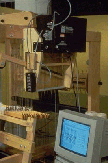
Fault Lines (1995) by Barbara Layne and Ingrid Bachmann, was described in Katherine’s blog. It was a work in which computer-assisted looms were programmed to translate recorded daily seismographic information between two locales: Montreal and Santa Monica, CA. Increments of cloth were then woven each day by individual handweavers at each of the sites. The tectonic movements of the earth were thus recorded through one of the earliest and one of the most recent technologies.
Very Nervous System (1986-1990) by David Rokeby was a non-visual interactive sound installation that made use of video cameras, image processors, computers, synthesizers and a sound system to create a space in which the movements of one’s body created sound/music. Upon entering a room, the viewer became aware that his/her simple displacement of air caused a reaction of sound within the environment., altering the otherwise seemingly empty site. As Wired said of this work: "David Rokeby's Very Nervous System does a number of things. But mostly it does this: it watches you. This piece of art tracks the slightest movement of the human body. Rokeby wires up a space the size of a dance floor, and whatever moves through it is sucked into the artwork. Very Nervous System makes something out of you. It turns you into a symphony. Or a jazz song. Or a samba."

And Paul Sermon's Telematic Dreaming (1992) - we described in an earlier blog. But here it is again. A bed was set up within the gallery space onto which an image of a person in another bed was projected in real-time. The viewer was then able to interact with this telepresence producing what one reviewer called “an uncanny exchange.”
The basic technical system consisted of a camera situated above a queen-size bed. The camera received an overhead view of the bed. The image of the bed and someone lying on it, was sent via ISDN lines and teleconferencing systems to a video projector situated above another bed in a geographically distant location. The live image was projected down on to the bed, and with it the live, life-size image of the person. Another video camera situated next to the video projector sent an image of the projection and the second person lying on the bed under the projection, back to the first bed.
You can google all three works for more information. What strikes me at the moment is that while they are all “installations” and exhibited in a gallery, they are also “performances” and either involve performers (handweavers in Fault Lines) or audience members who do something (perform) to create the work. And that all three deal with the physical or material and the virtual, challenging the notion, prevalent at the time (remember William Gibson?), that these two realms were separate.
Posted by newradio at 10:17 AM | Comments (0)
September 02, 2004
M@ggie's Love Bytes
theater that dares
M@ggie's Love Bytes is a dance theatre performance ocurring in real and virtual (net) space. Participants - M@ggie and her lovers - interact through sound, text, and realtime video conferencing via the Internet. Love Bytes are given to M@ggie in the form of digital signals. The hardcore performance group consists of a choreographer, two musicians and three dancers.
This is a post-modem project, using the Internet as a platform for interaction. The restrictions of the chosen technology are used as an expression of Now! This project focuses on connection and disconnection, appearance, disappeareance and reappearance. Fluctuations in transmission and reception rates between the geographically separated participants are embedded in the expression of the performance, and define the dramatical development of the piece.
M@ggie is represented physically by three dancers, each dressed in bra and pants and equipped with a plunger. M@ggie relates strongly to the soundscape. M@ggie's lovers enter the performance from such diverse locations as Cologne, Yokohama, London, San Francisco and Copenhagen.
While some remote participants are regularly active as collaborators (musicians and dancers who are involved in rehearsals), others enter the project for the first time during performance. You'll find a downloadable RealVideo (494k) introduction to M@ggie HERE which'll give you more of an idea about who she is :)
Each participant is free to choose their own form of interaction. Each remote participant experiences their own unique performance on their computer desktops and in their local spaces - some choose informal party settings, others create their own scenic settings inviting their own audiences. In addition to the live interactioin described above, audio and visual gifts from visitors deposited in M@ggie's Giftbox, are integrated into the performance. By using several interwoven physical and virtual platforms for interaction, a multitude of simultaneous telephonic spaces occurs between the diverse physical locations.
Here is a review from the show @ Electra, march '96.
Posted by jo at 06:49 PM | Comments (0)
The Crazy Wisdom Sho
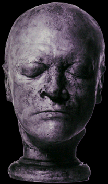
Remote Teleprompting
Unfortunately, there's no video archive on George Coates' web site, which seems to have been abandoned in 2001. However, you can read about The Crazy Wisdom Sho, an experiement in live theater and the Internet in which live performers in a San Francisco Civic Center Theater were onstage surrounded by web-enabled teleprompters. At selected moments, the actors were controlled by online participants who had submitted Crazy Wisdom to the teleprompters via the website.
And, according to George Coates, "(The George Coates Performance Works) produced a show called the "Nowhere Band" that included an inter-actor named Ralph who arrived on-stage via the internet every night at 8:30 PM PST for a five week performance run. This was the first distributed live performance ever to occur as part of a regularly scheduled theater run. Audiences in our theater would see Ralph blow into his pipes to sound a `C' note in Australia establishing the musical key, as the Nowhere Band in San Francisco tuned their instruments to his bagpipe for the first number played in the show. This show premiered at our civic Center theater in San Francisco in 1994." This quote is from "The New Performer" by Sheila A. Malone.
Malone continues: "The idea of space and real are connected with the idea of a time-based experience. The relationship of live characters is absolutely dependent on the interaction with the virtual characters. George Coates takes these ideas of real and hyperreal and completely mesmerizes audiences with the production of "20/20 BLAKE: The Visions Of William Blake." George Coates describes the performance, "at one point we had even hacked a way to make two SGI graphics engines run simultaneous stereographic interactive animation programs enabling audiences wearing polarized glasses to experience stereo 3D illusions of volumetric space interacting in real time with live actors on a stage. (This enabled, for example, a flock of birds to appear to hover over the stage and audiences, swooping down to harass the live actor, chasing the actor around the stage wherever the actor chose to go - in real time)." Here Coates and his company of actors, technicians, and virtual images are merged with the audience into a space created and controlled by the computer and its operators. The definition of performer has changed. But the presence of space and time are consistent common denominators in the performance."
Posted by jo at 06:08 PM | Comments (2)
ILoveBees Breaks Into the "Real World"

Beekeeping Mobs
Posted by vpisteve at 11:27 PM on Alternative Reality Gaming Network: August 24, 2004. It all began at 6:07 am PDT. Payphones from coast to coast began to ring. A twelve-hour wave of carefully planned phone calls began to sweep the country, and Halo fans, Beekeepers, the Media and the just plain curious were there to try to intercept them.
This morning, we got to find out what was in store for those who were following the events of Dana and the rogue AI attacking her aunt's website. While many were expecting Halo 2 demo disks, what they got instead was one of the largest, most complicated distributed interactions in ARG history. Hundreds of people around the country descended upon over 200 locales, working as a team to answer phone calls correctly, in order to unlock a series of audio clues.
While we don't have the space here to go into the story itself (for that, check the links below), here's how the whole thing worked: Players were presented with a web page that listed 30 blocks of seven GPS coordinates, which turned out to represent payphones around the country. Each location had a specific time attached, and each block of seven locations had a common password. As the phones started ringing at the exact corresponding time, players realized that they must respond correctly to the voice on the other end in order for something to happen. It was determined that players needed to provide the nickname for the AI that was calling them, plus the password listed for their location. If successful, the web-page immediately updated, indicating success. Two successful responses per group of seven then resulted in an audio file being unlocked. Players successfully unlocked 22 of 30 files the first day, with another chance to unlock the remaining ones every 24 hours. These audio files, when assembled, are revealing a fascinating story.
And this is only the beginning!
Forums and IRC channels broke all records today. The main chat room, #beekeepers, peaked at over 300 users at one point. In addition, the press is taking notice of what's going on. Word is that G4TV's Pulse will be airing a story about ilovebees this Friday, so stay tuned.
Here's a video of one event in Georgia. (6.7 MB)
Unfiction Ilovebees Forums
Guide
Quickstart
Wiki
Chat
Plot Timeline
Photo credits
Berkeley: Stitch
Burbank: MrBabyMan
See also This Week in ARGs: Flash Mobs of Beekeepers?? and I Love Bees.
Posted by jo at 10:27 AM | Comments (2)
September 01, 2004
Observing the net
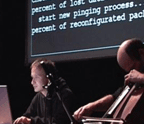
Ping Me a Melody
"Ping Melody is a music-net-performance. Temporary and unique state of all actions of Internet users has an influence on form of music composition. Musician (instrumentalist or singer) is playing on acoustic instrument/singing and sounds coming from instrument/voice are shared in packets of data information (granulated), then transmitted to selected Internet location (as "ping" unix command).
Most of net artists are using some specific possibilities of Internet: they are working with WWW, streaming, etc. In Ping Melody I treat Internet not so much as a tool which functions in given way, but as a space, that can be observed."
Posted by jo at 06:43 PM
more on avatar performance and definitions
The following is an email from Helen Varley Jamieson. I wrote to Helen in early August saying that we were really struggling with definitions for the various forms of performance--largely because the works themselves are breaking definitions down--and asking her for a definition of "avatar performance." We (the organizers) have since come to question our categories--but Helen's response is a good one and well worth reading.
From: Helen Varley Jamieson
Date: Mon, 9 Aug 2004 12:56:22 +0200
To: Helen Thorington
Subject: Re: Re the networked_performance blog
hi helen,
there are lots of different terms & definitions & many of them are problematic for all sorts of reasons. that's why i made up the term 'cyberformance' in 2000 & have been using that since then to describe what i do. my definition of cyberformance is the use of the internet to bring remote performers together in real time for live theatrical/performance events. this includes purely online performances (where the audience must also be online); performances for a proximal audience (who are together in a physical space where the performance takes place), or a mix of both. the essential thing is that the performers are coming together via the internet.
to me, "avatar performance" would mean that the performers are represented by avatars, much like puppet theatre. so the cyberformance work that i & avatar body collision has been making includes avatar performance, but it's not limited to that - we also use "web cams": (sometimes with puppets!) & live performance (we talk about this as being multiple stages, & layers of re/presentation). "avatar performance" wouldn't necessarily have to involve the internet - i know of a group in belgrade who are developing what they call "avatar theatre" & at the moment it exists as a navigable cd-rom with avatar characters; they plan to give a live performance using a LAN in a gaming centre - so that would be avatar performance without being on the internet.
then there is the term "networked performance" - which i guess includes cyberformance but also other forms of networked performance that don't involve the internet.
does this help? it's an important discussion to have ... i haven't had a chance to read the blog for a few days but i will try to catch up a bit over this week & will have a look at the categories you're working on.
h : )
for earlier posts on avatar performance.
Posted by newradio at 09:44 AM | Comments (0)

